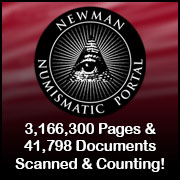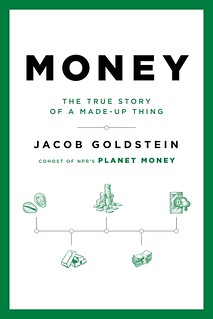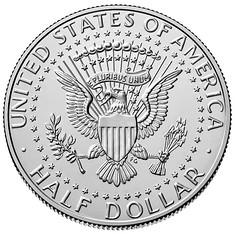
About UsThe Numismatic Bibliomania Society is a non-profit association devoted to the study and enjoyment of numismatic literature. For more information please see our web site at coinbooks.org SubscriptionsThose wishing to become new E-Sylum subscribers (or wishing to Unsubscribe) can go to the following web page link MembershipThere is a membership application available on the web site Membership Application To join, print the application and return it with your check to the address printed on the application. Print/Digital membership is $40 to addresses in the U.S., and $60 elsewhere. A digital-only membership is available for $25. For those without web access, write to: Charles Heck, Treasurer AsylumFor Asylum mailing address changes and other membership questions, contact Chuck at this email address: treasurer@coinbooks.org SubmissionsTo submit items for publication in The E-Sylum, write to the Editor at this address: whomren@gmail.com
BUY THE BOOK BEFORE THE COIN |
- WAYNE'S WORDS: THE E-SYLUM OCTOBER 11, 2020
- CHARLES DAVIS LITERATURE SALES ANNOUNCED
- BALDWIN'S CHRISTOPHER COMBER LIBRARY SALE
- KOLBE & FANNING'S "CATALOGUE OF CATALOGUES" SALE
- SCRIPOPHILY AUGUST 2020 ISSUE PUBLISHED
- INTERVIEW: 'MONEY' AUTHOR JACOB GOLDSTEIN
- ALLEN BERK (1929-2020)
- VIDEO: KOLBE & FANNING 100TH SALE
- VIDEO: HIGHFILL RECEIVES ANA PRESIDENT'S AWARD
- VIDEO: MEXICAN NUMISMATIC LITERATURE
- VIDEO: NEW WOW! HISTORY SEGMENTS
- NOTES FROM E-SYLUM READERS: OCTOBER 11, 2020
- QUERY: PLASTER MYSTERY MEDALS
- SANDHAM'S COINS, MEDALS AND TOKENS OF CANADA
- VOCABULARY TERM: NATIONAL MEDAL
- S. ARCHIE HAMILTON (1890-1920)
- HARVEY STACK'S NUMISMATIC FAMILY, PART 80
- SUBSCRIBER PROFILE: BRIAN HERRIOTT
- HISTORY OF ANA'S BEN E. KEITH ENDOWMENT
- WRITING A GUIDE BOOK OF COLLECTIBLE POSTCARDS
- THE 1860 SNOWDEN MINT BOOK COLLECTION
- COLTRANE COLLECTION SELECTIONS PART 1
- DIX NOONAN WEBB OCTOBER 2020 BANKNOTE SALE
- NUMISMATIC NUGGETS: OCTOBER 11, 2020
- GOLD IDES OF MARCH COIN OFFERED
- DELIBERATELY DAMAGED COINS AND TOKENS
- COUNTERMARKED HOLED COINS OF THE PHILIPPINES
- IRISH MICHAEL COLLINS SOUVENIR BANKNOTE
- MUDLARKER'S FINDS
- CASCADE REFINING DATE-STAMPED INGOTS
- THE BIBLIOMANIAC'S MANTRA
- LOOSE CHANGE: OCTOBER 11, 2020
Click here to access the complete archive
Click here to unsubscribe (scroll down)
To comment or submit articles, reply to whomren@gmail.com
Content presented in The E-Sylum is not necessarily researched or independently fact-checked, and views expressed do not necessarily represent those of the Numismatic Bibliomania Society.
WAYNE'S WORDS: THE E-SYLUM OCTOBER 11, 2020
 New subscribers this week include:
Pedro Meza Servin, courtesy of Adrián González-Salinas; and
Ken Kipperman.
Welcome aboard! We now have 6,566 subscribers.
New subscribers this week include:
Pedro Meza Servin, courtesy of Adrián González-Salinas; and
Ken Kipperman.
Welcome aboard! We now have 6,566 subscribers.
Thank you for reading The E-Sylum. If you enjoy it, please send me the email addresses of friends you think may enjoy it as well and I'll send them a subscription. Contact me at whomren@gmail.com anytime regarding your subscription, or questions, comments or suggestions about our content.
This week we open with FOUR numismatic literature sales, a periodical issue, an author interview, an obituary and four videos.
Other topics this week include Mexican numismatic literature, Alfred Sandham and early numismatics in Canada, national medals, the ANA's Ben E. Keith endowment, banknote auctions, the gold EID MAR coin, damaged and countermarked coins, mudlarking finds, and date-stamped silver ingots.
To learn more about the Carlyon-Britton, Richard Cyril Lockett and Mortimer Livingston Mackenzie collections, the John W. Kline sale broadside, slave hire badges, prison money, the ventriloquist with a peg leg and no dummy, the Libertas Americana medal, the David Rittenhouse medal, the Invade Cuba dollar, and the starriest U.S. coin, read on. Have a great week, everyone!
Wayne Homren
Editor, The E-Sylum
CHARLES DAVIS LITERATURE SALES ANNOUNCED
Numismatic literature dealer Charlie Davis submitted this note announcing two upcoming sales. Welcome back!! -Editor
 After a hiatus of 3 1/2 years, we are finally back to issuing print catalogues. Given the extra time we have had in the office by not being able to attend shows, we
have been able write two - the first a Mail Bid Sale of 125 lots and the second a fixed price list of 1500. Both, drawing from the personal libraries of Dave Bowers,
Howard Newcomb and Ted Naftzger, are exclusively North American and British with continental and classical excluded. As we suspect that our mailing list for catalogues
may be a bit stale since we last had a mailing in February 2017, we would like to hear from those who want to ensure they are on it. Please e-mail us at
Numislit@aol.com
.
After a hiatus of 3 1/2 years, we are finally back to issuing print catalogues. Given the extra time we have had in the office by not being able to attend shows, we
have been able write two - the first a Mail Bid Sale of 125 lots and the second a fixed price list of 1500. Both, drawing from the personal libraries of Dave Bowers,
Howard Newcomb and Ted Naftzger, are exclusively North American and British with continental and classical excluded. As we suspect that our mailing list for catalogues
may be a bit stale since we last had a mailing in February 2017, we would like to hear from those who want to ensure they are on it. Please e-mail us at
Numislit@aol.com
.
To visit Charlie's websites, see:
Charles Davis
Numismatic Literature
(https://www.numisbook.com/)

BALDWIN'S CHRISTOPHER COMBER LIBRARY SALE
Coming up on October 15, 2020 is the Christopher Comber numismatic library sale by Baldwin's of St. James. Here are some selected lots. -Editor
Lot 5009: The Carlyon-Britton Collection of Coins
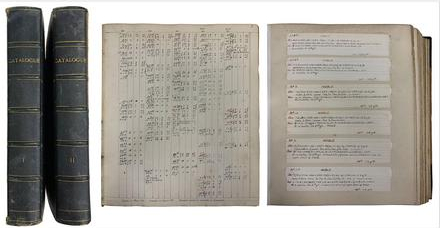
Carlyon-Britton, Major Philip William Poole (1863-1938): The Carlyon-Britton Collection of Coins: the collector's unique record of the coins in the collection: two quarto index books, bound in three-quarter morocco and cloth boards, his bookplate to both; each volume with some hand-written notes and the coins individually and lovingly described on a moveable tab, 6 to a page, in red and black inks, showing purchases from c. 1910-1918; Vol. I, dated May 1913, 'Hammered English Gold Coins 1257-1662'; Vol. II, Henry VII – Charles II (though ending with Elizabeth), a superb record recorded in immaculate detail (Manville, Biographical Dictionary, p.50; cf. also BNJ 1917, p. 242 & BNJ 2001, p.144), in excellent condition (2)
Lot 5026: Richard Cyril Lockett Collection
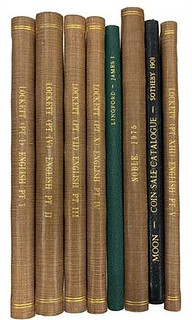 Lockett, Richard Cyril: Catalogue of the Celebrated Collection of Coins formed by the late Richard Cyril Lockett, Glendining Auctions, London 1955-1961, the English
series, complete in 5 parts; Pts. I & II with added 'Collections and Finds', printed prices in catalogue; Pt. III hand-priced throughout and (copied) list of buyers' names; Pt. IV, printed prices; Pt. V, hand-priced throughout and (copied) list of buyers' names, separately bound in brown cloth, titled in gilt on spine; Lingford, Herbert M.: Catalogue of the important Numismatic Collection, Part II, Gold, Silver and Copper issues of James VI of Scotland and James I of Ireland, Glendining Auction, 20-21 June 1951, with prices realised and buyers' names, hard bound, leather spine; Moon, J. E., Sotheby Auction, 1901, hand-priced with buyers' names, modern hard bound, leather spine; Noble, B. R., Glendining Auction, December 1975, hard bound, some foxing, stains and one repair to Moon, otherwise all in excellent condition (8)
Lockett, Richard Cyril: Catalogue of the Celebrated Collection of Coins formed by the late Richard Cyril Lockett, Glendining Auctions, London 1955-1961, the English
series, complete in 5 parts; Pts. I & II with added 'Collections and Finds', printed prices in catalogue; Pt. III hand-priced throughout and (copied) list of buyers' names; Pt. IV, printed prices; Pt. V, hand-priced throughout and (copied) list of buyers' names, separately bound in brown cloth, titled in gilt on spine; Lingford, Herbert M.: Catalogue of the important Numismatic Collection, Part II, Gold, Silver and Copper issues of James VI of Scotland and James I of Ireland, Glendining Auction, 20-21 June 1951, with prices realised and buyers' names, hard bound, leather spine; Moon, J. E., Sotheby Auction, 1901, hand-priced with buyers' names, modern hard bound, leather spine; Noble, B. R., Glendining Auction, December 1975, hard bound, some foxing, stains and one repair to Moon, otherwise all in excellent condition (8)
Lot 5032: Numismatic Letters
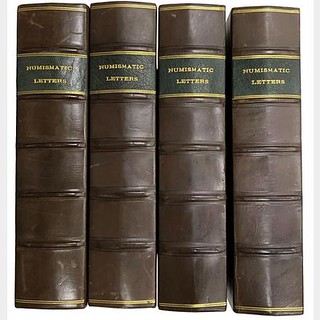 Numismatic Letters: Four leather-spined book-like holders containing a collection of letters on numismatic subjects by many of the most recognisable names: (I) to Richard
Cyril Lockett from George Brooke, with manuscript notes on the coinage of Offa and the gold penny of Edward the Confessor, with a miscellaneous 'hotch-potch' of letters, notes, etc., relating to numismatics, 18th – 20th century; (II) to Robert Day of Cork, Irish antiquarian, upwards of 60 letters, c. 1875-1900, from other antiquarians, collectors, Irish peerage, etc, covering a wide range of mostly Irish topics (with list); (III) to F. S. Cockayne, many token-related and including a typescript catalogue of Anglesey tokens autographed and from R. Dalton; (IV) to J. H. Burn and including notes in his hand; to and from Helen Farquhar, including Max Rosenheim; to R. A. Holbyn, including from Hyman Montagu, all have been sorted and with typed descriptions of most; with a signed reprint by Michael Dolley on letters from Aquilla Smith to Richard Sainthill, 1972, a fascinating record of a more gentle and less money-driven age (lot)
Numismatic Letters: Four leather-spined book-like holders containing a collection of letters on numismatic subjects by many of the most recognisable names: (I) to Richard
Cyril Lockett from George Brooke, with manuscript notes on the coinage of Offa and the gold penny of Edward the Confessor, with a miscellaneous 'hotch-potch' of letters, notes, etc., relating to numismatics, 18th – 20th century; (II) to Robert Day of Cork, Irish antiquarian, upwards of 60 letters, c. 1875-1900, from other antiquarians, collectors, Irish peerage, etc, covering a wide range of mostly Irish topics (with list); (III) to F. S. Cockayne, many token-related and including a typescript catalogue of Anglesey tokens autographed and from R. Dalton; (IV) to J. H. Burn and including notes in his hand; to and from Helen Farquhar, including Max Rosenheim; to R. A. Holbyn, including from Hyman Montagu, all have been sorted and with typed descriptions of most; with a signed reprint by Michael Dolley on letters from Aquilla Smith to Richard Sainthill, 1972, a fascinating record of a more gentle and less money-driven age (lot)
Lots 5034-5044: Seaby Fixed Price Lists
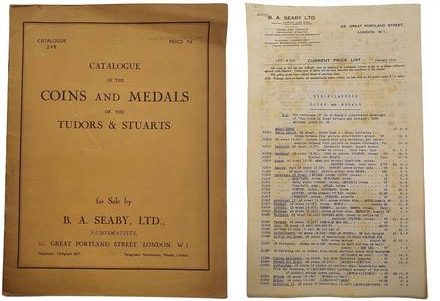
Seaby [B. A. Seaby, Ltd.]: Coins and Medals offered for sale; the early duplicated lists in roneoed typescript on foolscap, 1926 – 1938 and believed by Comber to be the most complete set extant; most re-stapled and generally in good order and very rare , 1935: January, M.238; February, X.239; March, M.240; March, M.241 [Brand Collection]; April, M.242; May, M.243; May, LM.244; May, LM.245; June, C.246; [July], 248, this 'Catalogue of the Coins and Medals of the Tudors and Stuarts', 22pp., printed in 2-column style, soft card; August, M.249; September, M.250; September, C.251; October, E.252; October, M. 253; November, M.254; December, M.255
B. A. Seaby Ltd. H. A. (Bert) Seaby (d. 1979), son of the artist, illustrator and print-maker, Allen William Seaby (1867-1953), joined the coin department at Spink & Son in 1919 and whilst there, in 1926, he published his first catalogue, The Milled Silver Coinage of England. Later that same year he was able to establish his own business, B. A. Seaby Ltd., and right from the start he produced duplicated lists of stock for sale. Lots 5034 to 5043 are not a complete set and it is believed only one or two such sets survive, but it is an amazing record of the range of coins and medals for sale. Generally, the lists are in good order, but many have been folded and the old rusted staples have been replaced throughout. In 1929 he published the first edition of A Catalogue of the Coins of Great Britain and Ireland and an excellent set follows.
To read the catalogue, see:
https://bsjauctions.com/cat-pdf/16/10/2020.pdf
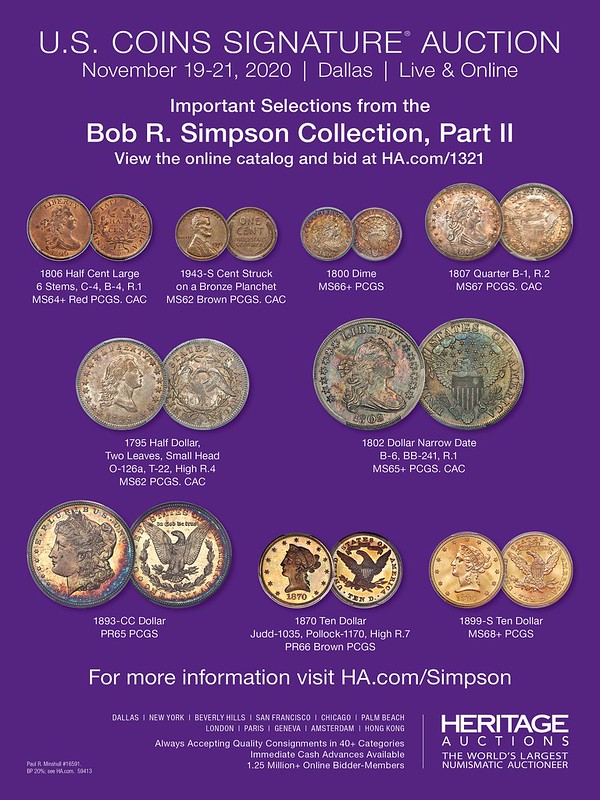
KOLBE & FANNING'S "CATALOGUE OF CATALOGUES" SALE
As noted last week, here's the announcement of the Kolbe & Fanning sale of the P. Scott Rubin library. What a delight for bibliophiles! -Editor
KOLBE & FANNING'S "CATALOGUE OF CATALOGUES" SALE
Kolbe & Fanning Numismatic Booksellers are conducting our 157th auction sale on Saturday, October 24, 2020. The 500-lot sale features highlights from the extraordinary library of American coin catalogues collected over the course of half a century by P. Scott Rubin. Featuring catalogues published between 1851 and 2020, the Rubin Library is the most extensive library of American coin catalogues to be offered in many years. While subjects cover the gamut of numismatic topics, the library focuses on catalogues from dealers within the United States, though some foreign catalogues of American interest are also included.
Some highlights of the sale include:


Lots 34 and 83
Lot 34: a rare, large-size broadside from Bangs, Merwin & Co., dated April 8, 1871 and featuring material from the collection of John W. Kline
Lot 83: a plated copy of S.H. & H. Chapman's 1890 sale of the Thomas Cleneay collection, in the original gilt-printed white paper covers
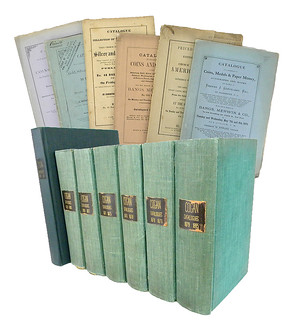
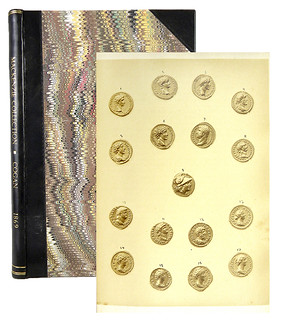
Lots 157 and 163
Lot 157: the exceptional set of Edward Cogan catalogues from the Stack Family Library, including the extremely rare 1859 Tripler sale, augmented by Rubin to include 67 of the 70 catalogues listed by Adams, plus other material
Lot 163: Cogan's 1869 sale of the Mortimer Livingston Mackenzie collection, with five photographic plates, the first photographically illustrated U.S. coin catalogue

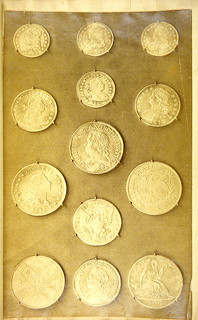
Lots 233 and 393
Lot 233: a comprehensive set of Heritage catalogues, featuring approximately 720 catalogues and comprising about 96% of the sales issued by the firm
Lot 393: H.G. Sampson's extremely rare 1881 Montanye catalogue with four fine photographic plates

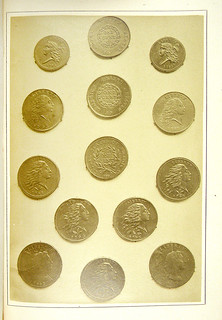
Lots 395 and 428
Lot 395: a nearly complete run of Hans M.F. Schulman catalogues, 1940–1975
Lot 428: William Strobridge's rare catalogue of the Seavey collection, with five photographic plates illustrating pieces from this collection, purchased en bloc by Lorin Parmelee


Lots 438 and 495
Lot 438: the exceptionally rare 1884 Adolph Weyl catalogue, featuring the first photographic illustration of an 1804 dollar
Lot 495: W. Elliot Woodward's Sale 92, a legendary rarity in the series.
Bids may be placed via post, email, fax or phone, as well as online. Kolbe & Fanning use Auction Mobility as our third-party online bidding platform. Auction Mobility is an app-based platform allowing users the ability to participate in the sale through phones, tablets and computers. To register for the sale, bidders must go to bid.numislit.com and sign up. Once you have set up an account, you may browse lots, place advance bids, or participate in the live sale online. Those wishing to participate on their devices can download the Kolbe & Fanning app through the Apple or Google Play Store.
The printed catalogue of Sale 157 has been mailed to active customers within the United States. As international mail speeds have been slowed by the Corona situation, we are asking our international clients to rely upon the electronic catalogue, though we are happy to provide printed copies upon request. A PDF of the printed catalogue has been posted to our main website at numislit.com for those who prefer that format. Bids placed via post, email, fax or phone must be received by October 23, the day before the sale, in order for them to be processed. Advance absentee bids may also be placed at any time online at bid.numislit.com. Live internet bidding will be available during the sale itself through the same platform.
Kolbe & Fanning Numismatic Booksellers LLC is a licensed and bonded auction firm in the State of Ohio. For more information, please see the Kolbe & Fanning website at numislit.com or email David Fanning at df@numislit.com. To register for the sale, go to bid.numislit.com. We look forward to your participation.
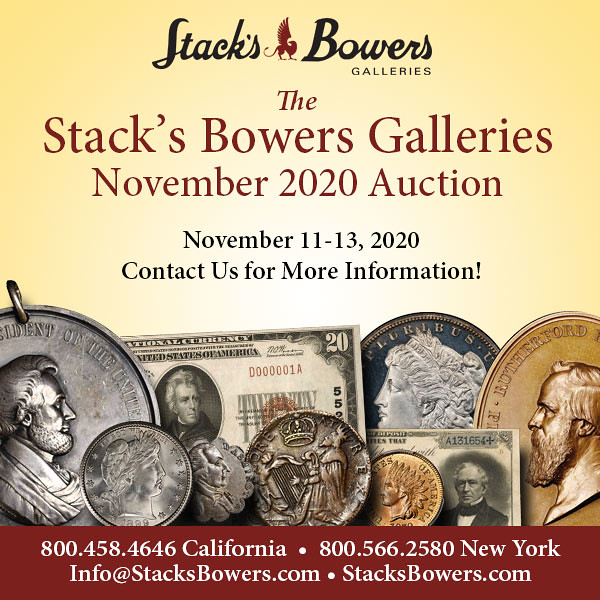
SCRIPOPHILY AUGUST 2020 ISSUE PUBLISHED
Franky Leeuwerck recently published on his blog this note about a recent issue of Scripophily magazine from the International Bond and Share Society (IBSS). -Editor
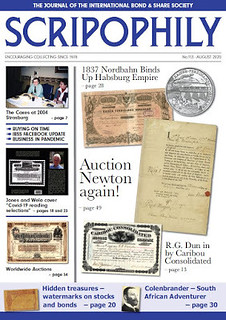 Buckle up! Scripophily magazine brings you into the world of antique stocks and bonds
Buckle up! Scripophily magazine brings you into the world of antique stocks and bonds
Compelling tales, business plot twists and memorable personalities keep you spellbound. Scripophily magazine uncovers the stories of historic and artistic securities. In addition, reports from the auction markets help you to stay up-to-date. This periodical is the flagship of The International Bond and Share Society (IBSS) and appears three times a year.
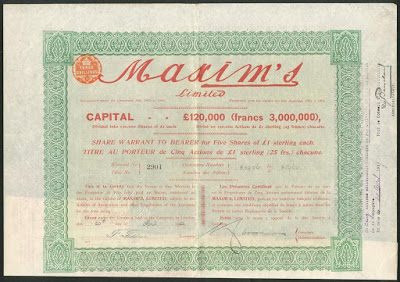
In Scripophily magazine you'll find out about the latest discoveries. This rare share certificate realized £160 at SPINK's May 2020 auction. The most famous restaurant not only in Paris but also in the world, Maxim's was in 1926 owned by this British company.
Scripophily magazine is the world's most comprehensive and insightful publication for passionate collectors and researchers of antique securities. Its 2020 August issue brings 50 pages of scripophily news, in depth articles, pictures of collector friends, auction reports and quality images of stunning, historic and rare stocks and bonds.
Here is a summary on the topics brought in the latest issue :
- The History of Worldwide Scripophily Auctions, a review of Tim Welo's book
- Buying on Time, Was this share certificate bought on margin?, about the Lake Superior Iron and Chemical Company (NY)
- Western Union Telegraph Company, letter to the editor about Gandhi and India's independence struggle
- Collectors Clearinghouse, learn about the Bridgeport & Port Jefferson Steamboat Company
- Nothing New about FaceTime or Zoom, the American Televue Company
- Dow Jones, a History of Dow Jones Averages Since 1884, review of Dr. Peter Jones' book
- Large Scale Snubbing went on in Cleveland in the 1920s, brings the story on The Gabriel Snubber Manufacturing Company
- Misadventures in Mining : Dutch Investors and R. G. Dun at the Caribou Mine
- A Visit to the New York Stock Exchange Archives
- (Kaiser) Ferdinand's Nordbahn
- Watermarks in Scripophily, part 1 introduction
- The Dow Jones Company and its Averages, extract from Dr Peter Jones' book
- Pacific Mail Steamship, idem
- Johan Colenbrander and Colenbranders Matabeleland Development Company
- My British Railway Treasure, a testimony on collecting early British railway scripophily
Subscribing to Scripophily magazine brings you valuable free extras :
- The IBSS Directory brings you in contact with fellow collectors. Many of those are experts in their field, often share common interests with you, and possibly live nearby. The Directory contains members from more than 40 countries.
- The Newsletter, so you may keep up with what is going on.
- Access to all content on the IBSS website, including digital versions of previous issues of Scripophily magazine, the online forum, special theme galleries, and the like.
- Newsflashes on the website focus on hot topics that can't wait for the next issue of the magazine.
- Get extra credibility : being listed as a member is a good reference in any deals made remotely with parties previously unknown.
A 1-year subscription only costs £20 or $32 or €25. The magazine is published by IBSS. More info : https://scripophily.org/membership/join/
To read the complete article, see:
Buckle up! Scripophily magazine brings you into the world of antique stocks and bonds
(http://leeuwerck.blogspot.com/2020/10/buckle-up-scripophily-magazine-brings.html)
For more information on the International Bond and Share Society, see:
https://scripophily.org/

INTERVIEW: 'MONEY' AUTHOR JACOB GOLDSTEIN
Howard Daniel passed along this MSN interview with Jacob Goldstein, author of Money: The True Story of a Made-Up Thing. Thanks. -Editor
That doesn't mean that the bills in your wallet or the numbers in your bank account aren't real &ndash: it just suggests that the only reason money has value is because we believe it does. At least that's how Jacob Goldstein, host of NPR's Planet Money, explains it in his recently-released book, Money: The True Story of a Made-Up Thing. The book gathers fascinating accounts about money that go as far back as ancient times, all the way to the birth of cryptocurrency and the latest moves by the Fed.
While some finance books may be dense and dry, Goldstein mixes his "true story" of money through insightful, peculiar tales — that are laugh-out-loud funny, too. Money caught up with Goldstein to talk about his new book, the evolution of currency over the centuries, and why we can all have more money.
You present the history of money in a very detailed and even entertaining way. Where did the initial idea for this book come from?
When I got to Planet Money 10 years ago, I started doing historical stories and asking "what is money?" And it's a really interesting question. I was in my mid-30s and I thought of myself as well-informed about the world, but I realized I didn't really know what money was. When I started looking into it, what became clear is that there's this really rich history because money has been reinvented again and again. It became clear that following it over time, telling this series of origin stories of what money is and how people think about it would be a good book.
You write: "The thing that makes money money is trust." Does that mean the only thing that lends money any value is our willingness to believe in it?
I think you're right, yes. And clearly today, when we have money backed by nothing, that's true in a pretty straightforward way. You can't really do anything with a $100 bill that makes it worth $100. It's only the fact that people will give you stuff in exchange for that bill that makes it worth $100. In a subtler way, I think that was true even under the gold standard when $100 got you about five ounces of gold. But the "moneyness" of the gold is the trust. When a thing becomes money, whether it's gold or in other places cattle or cowrie shells, the money part is the trust. It's the belief that other people will accept the thing as money.
Have your views on money changed since finishing the book?
One of the big lessons of the book for me is that money has changed again and again. So, we're not done. Money is going to continue to change, and I think it was hard for me to really feel that lesson. I think there's such a strong tendency to innately feel like the way the world works is the default setting. But in fact, there are lots of different ways to do money, have banks or not have banks, and the way we do money will almost certainly continue to change. And I think I am much more aware of that and much more humble about trying to predict what's going to happen, or even what would be good or bad.
To read the complete article, see:
What Is Money? This Author Dug Into the Fun History of How a Made-Up Thing Came to Rule the World
(https://www.msn.com/en-us/money/markets/what-is-money-this-author-dug-into-the-fun-history-of-how-a-made-up-thing-came-to-rule-the-world/ar-BB19PtsC)
To read the earlier E-Sylum article, see:
NEW BOOK: MONEY
(https://www.coinbooks.org/v23/esylum_v23n37a04.html)

ALLEN BERK (1929-2020)
New York numismatist Allen Berk passed away recently. Here's his online obituary, plus remembrances from World War II Remembered co-authors Fred Schwan and Joe Boling, republished with permission from the October 3, 2020 issue of MPC Gram, the email newsletter for collectors of Military Payment Certificates and other military numismatica. -Editor
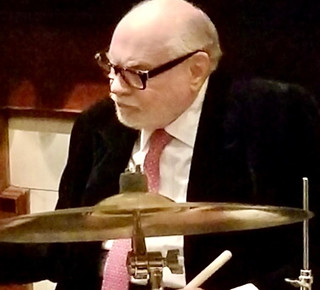 Lover of Life and Family! Devoted and adoring Husband to Marylou Delfino Berk, Loving Dad to George, Pamela & Valerie, sons-in-law Shyam & Dan, Grandfather to David and Matthew, Brother-in-law to KC Delfino and Marshall Levinson, proud Uncle to Morgan and Fiona. He was a Pioneer Member of SGI-USA, Value Creation Society all while fulfilling his musical career leading the Allen Berk Orchestra in New York City since the 1950's.
Lover of Life and Family! Devoted and adoring Husband to Marylou Delfino Berk, Loving Dad to George, Pamela & Valerie, sons-in-law Shyam & Dan, Grandfather to David and Matthew, Brother-in-law to KC Delfino and Marshall Levinson, proud Uncle to Morgan and Fiona. He was a Pioneer Member of SGI-USA, Value Creation Society all while fulfilling his musical career leading the Allen Berk Orchestra in New York City since the 1950's.
Born October 13, 1929 in Detroit, MI and raised in Cincinnati, OH, early childhood hardships along with gross experiences of Anti-semitism led Allen to seek and overcome his own personal challenges while influencing countless people as a result of his Buddhist practice for over 55 years. He instilled the importance to break down the walls of differences, to maximize the potential of life viewing every person as a unique individual and unfolding the never-ending ability to make change in one's life. He wanted to know everyone personally that he met.
Allen was a learned and avid numismatist and collector easily encouraged by his curious mind, artistic talent, love of history and extensive travel around the world. Since his passing peacefully on August 28, 2020, there has been such an overwhelming response, that, in lieu of flowers, etc., Allen would have considered it an honor, if donations were made to Soka University, which is dedicated to students leading a contributive life through their own distinctive success. Donations can be made online at https://give.soka.edu/ (write Allen Berk in the comments section or select memorial gift), or call Linda Kennedy at 949-480-4072.
To read the complete article, see:
ALLEN BERK
1929 - 2020
(https://www.legacy.com/obituaries/nytimes/obituary.aspx?n=allen-berk&pid=196750827)
Here's a remembrance from Joe Boling. -Editor
I don't remember how Allen and I met, but it was long ago. In 1998 I spent 3-4 nights bunking with him and his wife, Mary Lou, in their then-Upper West Side condo (they later moved to the Upper East Side of Manhattan). During that 1998 visit Mary Lou and I saw Madama Butterfly at the Met, and three nights later Allen and I saw The Tales of Hoffman. I don't remember why I was in New York that week (late February). I can't think of anything numismatic that would have pulled me out of Seattle.
In March 2007, during CPMX, we went to a community college outside Chicago to see his daughter performing in Proof. I have seen that play six times, and that performance is tied for the best of them. Why did a fellow who was 77 have a daughter of college age? Interesting story. Like Gene Hessler (whom Allen knew for decades), Allen was a career musician, playing percussion in club bands. One day in his middle age his group was rehearsing, expecting a singer to come by for an audition. In the middle of a set a young woman came in and sat near the front. At the break, they asked her what she wanted to sing, which confused her; she was just enjoying the music. Allen spent the rest of his life with her—the Mary Lou I have already mentioned. (The singer never showed up.)
Allen collected Japanese bonds, and I was feeding his collection from my sources in Japan for several years. Allen was a Fester. I recall him funning with us twice (Fest XII and Fest XV, and I believe he had his son with him at least once).
Allen was also a practicing Buddhist. I was a collector of all things numismatic from Japan. We were looking through my medal trays one day and he recognized the portrait on one of them—Ikeda Daisaku, leader of the Soka Gakkai sect of Buddhism in Japan. I was happy to place it into his collection. If you check the suggested donation target at the foot of his obituary, you will note a similarity to the name of the sect I just mentioned. I am sure it is not a coincidence. I will be making a memorial donation. Notice also the description of that school—dedicated to students leading a contributive life through their own distinctive success. I can't think of a better description for ALLEN BERK.
And here's one from Fred Schwan. -Editor
Allen Berk was a great collector, but more than that he was a genuinely good guy. I enjoyed collecting with him. I enjoyed chatting with him. He was also a great host as described by Joe.
I too cannot remember when I met Allen, but I can remember WHERE I met him. It was on a bourse floor in New York City. I can even remember that it was Ian Marshall's bourse table. I am not sure if it was at an ANA convention (aka World's Fair of Money) or Numismatics International show.
The very first time we met, we went off into some corner of the hall or building (again, I am not sure which) and chatted. I had a mixed World War II collection that I had bought from someone. It included a large proportion of Asian material. Allen bought the entire box. I suspect that a large part of that collection is still there, but I cannot be sure. Each year after the first meeting we met at the International. We did a little business, but we did a lot of chatting.
It was easy to like Allen. Every time we talked (usually on the phone) he would praise World War II Remembered in an extreme fashion. It is easy to like someone like that!
I am not sure why Allen did not start coming to the Fest sooner. Let's just say that it was my fault for not recruiting him more directly. Since Allen did not collect MPC, he did not appreciate the broad definition.
Once he started coming, he intended to come to all of them, but travelling became a problem. He called to apologize that he could not make it, and, of course, to chat.
To subscribe to MPC Gram, see:
https://guide.us13.list-manage.com/subscribe?u=10eb366ab80344a56657e0d5d&id=58874b37e1

VIDEO: KOLBE & FANNING 100TH SALE
Newman Numismatic Portal Project Coordinator Len Augsburger provided the following report on a new video added to NNP. -Editor
Kolbe & Fanning 100th Sale Video
 Held in conjunction with the June 2006 Long Beach show, Kolbe & Fanning's 100th sale was a milestone in the history of this firm that has served numismatic literature collectors since 1969. George Kolbe recently forwarded a videotape of this sale, which was digitized and is now posted on Newman Portal. While the quality of the tape is consistent with home video of the period, the video conveys well the flavor of the sale.
Held in conjunction with the June 2006 Long Beach show, Kolbe & Fanning's 100th sale was a milestone in the history of this firm that has served numismatic literature collectors since 1969. George Kolbe recently forwarded a videotape of this sale, which was digitized and is now posted on Newman Portal. While the quality of the tape is consistent with home video of the period, the video conveys well the flavor of the sale.
Bidding for frontline lots is considered and drawn out, while typical material moves more quickly. Highlights of the sale included a large paper copy of Hickcox's 1858 work on American coinage, one of five known (lot 42, realized $40,250, 00:17:57 into the video, and extending until 24:35, during which the lot was re-opened), and a superbly bound set of the first four large format Chapman brothers' auction catalogs issued with plates, ex. Harry W.Bass, Jr. (lot 479, realized $43,700, 01:54:45 in the video).
Link to Kolbe & Fanning's Auction Sale One Hundred video on Newman Portal:
https://nnp.wustl.edu/library/book/589357
Link to Kolbe & Fanning auction sale catalogs on Newman Portal:
https://nnp.wustl.edu/library/auctioncompanydetail/513111
VIDEO: HIGHFILL RECEIVES ANA PRESIDENT'S AWARD
These are selections from the David Lisot Video Library that feature news and personalities from the world of coin collecting. David has been attending coin conventions since 1972 and began videotaping in 1985. The Newman Numismatic Portal now lists all David's videos on their website at:
https://nnp.wustl.edu/library/multimediadetail/522852
Here's one on John Highfill receiving the 2020 ANA President's Award. -Editor
John Highfill Presented ANA President's Award at Tulsa Coin Convention 2020.
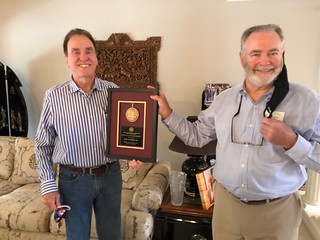 Steven Ellsworth, President, American Numismatic Association, John Highfill, President, Oklahoma Coin Exchange, David Lisot, Interviewer, CoinTelevision.com.
Steven Ellsworth, President, American Numismatic Association, John Highfill, President, Oklahoma Coin Exchange, David Lisot, Interviewer, CoinTelevision.com.
Longtime numismatist and silver dollar dealer John Highfill is honored with an American Numismatic Association Presidential Award given by Steven Ellsworth. John is founder of the National Silver Dollar Roundtable and author of the Encyclopedia of Silver Dollars.
An excerpt of the video is available for viewing on the Coin Television YouTube Channel at:
https://www.youtube.com/watch?v=8UPrNMdp0bU&feature=youtu.be

VIDEO: MEXICAN NUMISMATIC LITERATURE
Adrián González-Salinas passed along this Zoom video on Mexican numismatic literature. Thanks! -Editor
 Mexico's Numismatic Society is celebrating its 68th anniversary and Monterrey's Numismatic Society its 50th.
anniversary.
Mexico's Numismatic Society is celebrating its 68th anniversary and Monterrey's Numismatic Society its 50th.
anniversary.
We had a Zoom "Conversation about Mexican Numismatic Books" (in Spanish) at the 12 September 2020 sponsored by Monterrey's Numismatic Society and Mexico's Numismatic Society. We did talk about just Mexican numismatic literature. The panel included book collectors from Mexico City (Luis Gómez-Wulscher, Clemente Juárez), Germany (Ralf Böpple) and Monterrey, Nuevo León (myself).
I commented about the Numismatic Bibliomania Society (minute 36). It was a pleasure for me to talk about the NBS! I recommend watching it if you speak Spanish.

Luis Gómez-Wulscher
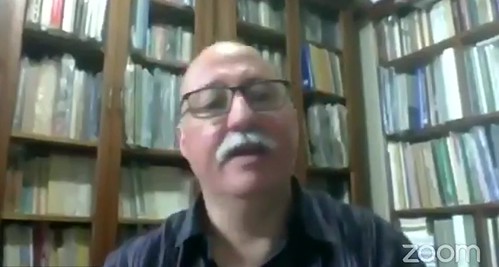
Adrián González-Salinas

Ralf Böpple
It's nice to put faces to some names we've known for some time. Love everyone's bookshelves! -Editor
To watch the complete video, see:
CONGRESO INTERNACIONAL NUMISMÁTICO : Day 2: Conversatorio "Bibliografía Numismática"
(https://www.coinnum2020.org/coinnumflix.html)
VIDEO: NEW WOW! HISTORY SEGMENTS
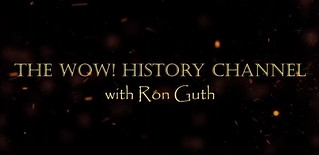 Ron Guth was published several more episodes on his numismatic YouTube channel Wow! History. These cover a wide range of fascinating topics. Take a look.
-Editor
Ron Guth was published several more episodes on his numismatic YouTube channel Wow! History. These cover a wide range of fascinating topics. Take a look.
-Editor
#5: New York City Draft Riot of 1863
In New York City in 1863, rioters went on a five-day rampage to protest the newly instituted federal draft. Hundreds died, thousands were wounded, and millions of dollars of property was destroyed and damaged. Find out why this was a Wow! moment in American history.
#6: Liberia

"Ship them back to Africa!", the racists cried. Liberia was formed in 1821 by the American Colonization Society, whose purpose was to raise money to purchase land in Africa and settle it with freed black slaves.
Learn how Africa's first and oldest republic was created.
#7: John Adams and God
In this episode of Wow! History, Ron Guth presents a 1799 Proclamation by President John Adams establishing a day of thanksgiving on April 25, 1799. Filled with religious sentiments, this document will change the way you think about the separation of church and state.
#8: Stamps as Money
During the Civil War, physical money disappeared as the general public hoarded all of the coins in circulation. As a result, conducting business became quite difficult. To solve this emergency situation, people began using postage stamps as money.
In this episode, Ron Guth describes the use of postage stamps as money, then the evolution from postage stamp envelopes to encased postage, an ingenious invention of a young entrepreneur named John Gault.
Finally, Ron describes how outside forces, including governmental innovations such as Postage Currency and "Greenbacks" killed the use of postage stamps as money.
#9: Slave Hire Badges
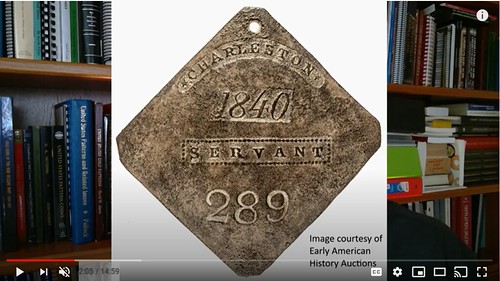
In the early to mid-1850's, Charleston, SC (and other cities) allowed African-American slaves to be hired out by their masters, but required them to pay a fee and wear a badge. This little-known part of history is explained in this episode.
#10: When Did the American Revolutionary War Start?
Wow! For awhile, I thought, incorrectly, that the American Revolutionary War started with the Declaration of Independence on July 4, 1776 and that events such as the Boston Tea Party, the Battle of Lexington-Concord, and the Boston Massacre followed in short order. In fact, the very opposite is true. In this bonus video, I put the events in their proper order and explain how they fit into the logical progression from the French & Indian Wars to the American Revolution.
#11: Bald Eagles on American Coins

The Bald Eagle is the national bird of America. This regal bird became an integral part of the Great Seal of the United States in 1782 and has been a frequent subject on American coins ever since. In fact, the first $10 gold piece minted in 1795 were called "Eagles" in recognition of the Bald Eagle that appeared on the back of the coins. Numerous artists came up with a variety of interesting depictions of the Eagle, ranging from scrawny birds and stylized poses to some very nice, natural depictions. In this video, Ron Guth surveys coins from the 1600's to date to find some of the more interesting versions of the American Eagle.
To watch or subscribe, see:
WOW! HISTORY
(https://www.youtube.com/channel/UCdEbo1rLcpvcdG_hBIKuGoA)
To read the earlier E-Sylum article, see:
VIDEO: RON GUTH DISCUSSES ALICE PAUL
(https://www.coinbooks.org/v23/esylum_v23n36a11.html)

NOTES FROM E-SYLUM READERS: OCTOBER 11, 2020
Prison Money Publication Update
Patrick O'Connor writes:
"I am writing to inquire about the mention in The E-Sylum Volume 21, Number 36, September 9, 2018 of the pending publication of a new book on prison scrip and tokens by Bob Hewey and Jim Delaney. Has it, in fact, been published and where it may be found?"
Bob Hewey writes:
"We are very close to having a first edition ready for publication. However, we (I) have encountered some technical problems. I am trying to use hyperlinks to provide a table of contents for the PDF version and have not figured out how to do that. Technical assistance would be appreciated."
As it turns out, Pat O'Connor is familiar with how to do this and offered his assistance. So stay tuned for further information on the book. Thanks! -Editor
To read the earlier E-Sylum article, see:
NOTES FROM E-SYLUM READERS: SEPTEMBER 9, 2018 : Prison Money Publication in the Works
(https://www.coinbooks.org/v21/esylum_v21n36a08.html)
More Stars on United States Coinage
Tom DeLorey writes:
 "If we put an asterisk on the word "circulating," I submit that the original reverse design Sacagawea dollar is also a circulating U.S. coin with stars on it. They number 17, representing the number of states in the Union when Lewis & Clark set off on their mission.
"If we put an asterisk on the word "circulating," I submit that the original reverse design Sacagawea dollar is also a circulating U.S. coin with stars on it. They number 17, representing the number of states in the Union when Lewis & Clark set off on their mission.
"Beginning in 2009, 13 stars replaced "IN GOD WE TRUST" on the edges of the Presidential dollars when that motto was moved to the obverse of the coins for political reasons. The same edge format was used on the Native American dollar coins introduced in 2009.
"The 2013 and 2019 Native American dollars have stars as part of their reverse designs.
"Finally, we have the Ronald Reagan dollar coin. Though never one of the great "stars" of Hollywood (who could ever forget "Bedtime for Bonzo!"), he does have a star on the Hollywood Walk of Fame!"
Thanks! Then of course there is the Kennedy Half dollar with 63 stars (50+13) on the reverse. Is there a U.S. coin with more stars than that? -Editor
To read the earlier E-Sylum article, see:
SEEING STARS ON UNITED STATES COINAGE
(https://www.coinbooks.org/v23/esylum_v23n40a10.html)
Query: Nina & Spencer Moosa Tokens

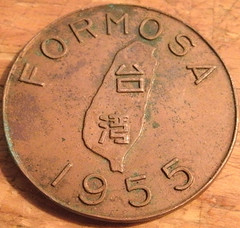
Jim Contursi writes:
"For several years now, I have been researching the tokens issued by Spencer Moosa and his wife, Nina. As often happens with research projects, I've hit a dead end, leaving some fundamental questions still unanswered. I'm wondering if I may prevail on you and your readership for assistance. Specifically, I am seeking to know where, by whom and in what quantity these tokens were struck, and what is their complete date range. (The only dates I can confirm are 1952, 1955, 1956 and 1957.)
I thank you in advance for any assistance you may be able to offer, and I appreciate all of your E-Sylum efforts. "
I've never seen these tokens before. Can anyone help? -Editor
2020 Covid-19 Outbreak Hard Times Token
Scott Sery writes:
"I read about the Covid medal contest at CSNS and thought you might find Dan Carr's covid medal [or token] to be an interesting piece."
Thanks! Here's an image. The issue is sold out. -Editor
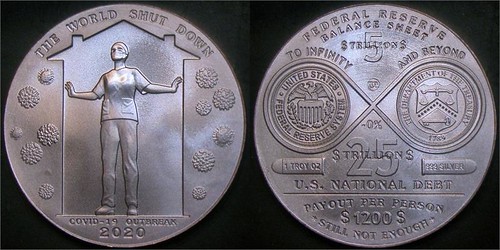
For more information, or to order, see:
2020 Covid-19 Outbreak & Economic Stimulus, Hard Times Token, 999 Silver (1 troy oz)
(http://www.dc-coin.com/2008hardtimestoken536minted-2-3-1-1-2-2-3.aspx)
On a related note, readers John Mutch, Aaron Oppenheim and I all came across this privately-produced "coin" offer. -Editor
Coins commemorating President Donald Trump surviving COVID-19 are already available for preorder at an online gift shop.
The $100 "Trump defeats COVID" coins are for sale on the website of the White House Gift Shop, which is not affiliated with the White House.
The commemorative coin went on sale before the president was released from the hospital.
The coin's listing has no photo but says it will ship Nov. 14. According to the website, 20% of the proceeds will be donated to COVID-19 prevention and cancer research.
To read the complete articles, see:
You can preorder a $100 'Trump defeats COVID' commemorative coin at White House Gift Shop
(https://www.usatoday.com/story/money/2020/10/05/trump-defeats-covid-commemorative-coins-on-sale-gift-shop/3628383001/)
White House Gift Shop selling 'Trump Defeats COVID' commemorative coin
(https://thehill.com/blogs/in-the-know/in-the-know/519745-white-house-gift-shop-selling-trump-defeats-covid-commemorative)
Flu more lethal than Covid, says 'symptom free' Trump : Gift shop sells victory coin
(https://www.thetimes.co.uk/article/flu-more-lethal-than-covid-says-symptom-free-trump-pfgt2cnzl)
To read the earlier E-Sylum article, see:
NOTES FROM E-SYLUM READERS: OCTOBER 4, 2020 : CSNS Announces Virus Medal Design Contest
(https://www.coinbooks.org/v23/esylum_v23n40a09.html)
Another Silver Conder Slave Token
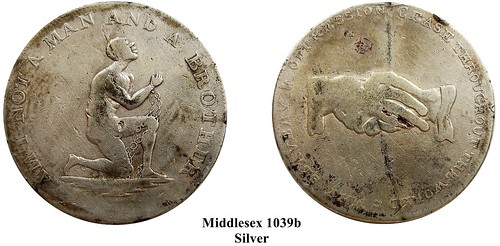
Jeff Rock's example
Jeff Rock writes:
"In the Sept. 20th issue Bill Groom asked about silver Conder tokens. I had a silver Middlesex 1039b in my collection - same dies, different edge. It was also well worn, but the wear was smooth and even, and it too had the look of a pocket piece, not something that knocked about in circulation.
England in this era was famous for its multitude of private clubs - I wonder if these worn silver pieces were admission badges of sorts, shown at the door to get into one where the members were all abolitionists?"
When I bought my piece it was supposedly the only silver example of one of the anti-slavery issues, though of course I always realize the word unique is thrown about far more often than is accurate! I'm not surprised to see another, but it is interesting that it is a completely different edge.
Sadly I don't know its silver content for sure. I sold it, along with a handful of other silver Conders to the guy who is putting together the best set of silver ones perhaps since Cokayne. Seemed fitting that the couple dozen I had that he lacked would go to the right home. It did look to be a less-fine silver content than the others I had, and 80% wouldn't surprise me.
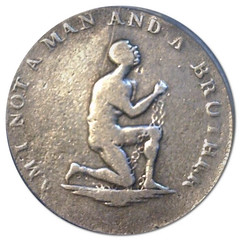
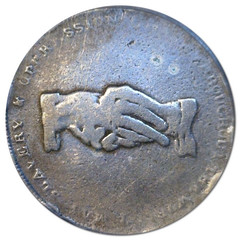
Bill Groom's example
Thanks! Interesting tokens. -Editor
To read the earlier E-Sylum article, see:
QUERY: SILVER CONDER SLAVE TOKEN
(https://www.coinbooks.org/v23/esylum_v23n38a14.html)
The Conder Token That Never Was
Eric Holcomb writes:
"Your story "HALF CENTS STRUCK ON TALBOT, ALLUM & LEE TOKENS" reminded me of the presentation I helped prepare for Bill McKivor of Seattle back in 2011 for the British Token Congress. It includes the pieces struck on half cents, as well as mules, etc. There was also an earlier version in 2009 for the one-time-only British Token Congress in Seattle."
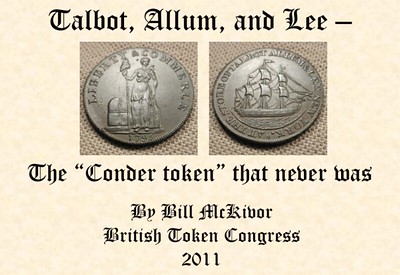
Thanks! I'll work with Bill to see about getting his research and price lists on the Newman Numismatic Portal. -Editor
To read the earlier E-Sylum article, see:
HALF CENTS STRUCK ON TALBOT, ALLUM & LEE TOKENS
(https://www.coinbooks.org/v23/esylum_v23n40a23.html)
More on Ventriloquist Joseph Askins

Jud Petrie writes:
"The latest E-Sylum has a depiction of the Joseph Askins token. He was born Thomas Haskey in 1771 (debatable) in Walsall England. He was known as "The man with one leg and two voices". He was the first ventriloquist known to have performed in a theatrical auditorium. Conflicting stories about him exist, some probably mythical. It is said that he fought for the British in the American Revolution and lost his leg in battle. (He wouldn't be fighting in the Revolution at the age of five). When he returned home it was reported that he assisted the local potato farmers plant their crops using his peg leg to make the holes to plant the crops.
"He was performing at Sadler's Wells theater in London in 1796, the year his tokens were issued. (Sadler's Wells theater opened in 1683 and is still in operation today, it's 6th location opened in 1998). It was also at this time that he changed to his stage name. He would hold conversations with 'Little Tommy' in his act, an invisible familiar. He was one of the last ventriloquists to perform without a dummy. The Askins Award is given annually to the ventriloquist judged to be the best.
"The dies for the Conder tokens were made by Jacobs and the tokens were sold to collectors by Skidmore. There are a five varieties of Askins tokens attributed by Dalton and Hamer as 250/251/252 plus two subtypes. As a magic token they are attributed by Kuethe as MT018."
Thanks! Great stories. -Editor
To read the earlier E-Sylum article, see:
THE JOHN ROSE BRITISH TOKEN COLLECTION
(https://www.coinbooks.org/v23/esylum_v23n40a18.html)
Tempus In Nummis
Nobody asked, but this week I happened on an AbeBooks listing for one of my favorite books, Tempus In Nummis. If the topic is of interest to you, consider the book. -Editor
Tempus In Nummis 2 Volumes Volume One: The History and Fundamentals of Dating in Numismatics Volume Two: The Romantic Story of Time Themes in Numismatics
Sweeny, James O. & Turfboer, Robert
Published by Numismatics International Oversi, 1992
For more information, or to order, see:
https://www.abebooks.com/Tempus-Nummis-Volumes-Volume-History-Fundamentals/30760481457/bd

QUERY: PLASTER MYSTERY MEDALS
Website visitor Whitney Allen writes:
"I found these while I was out thrifting. The back of the frame says "found these at an antique shop on Royal street in New Orleans. Bought a set of 61 of them. Bought in the fall of 1964, framed for myself in 1965." Can you tell me anything about them? Or point me in the right direction? These are all the exact same size - about 1.5in in diameter."
Here are several photos. Does anyone recognize these? Whitney can be contacted at wylerwestdesign@gmail.com or mitchandwhitney@gmail.com . -Editor
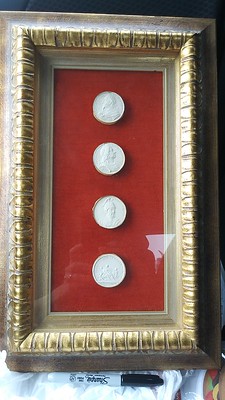
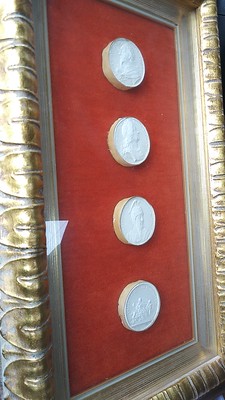
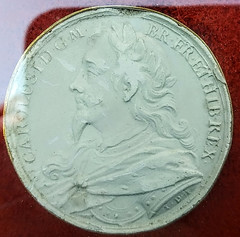
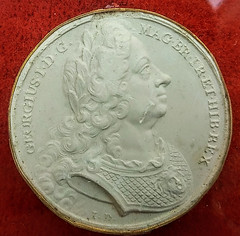
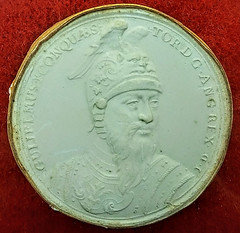
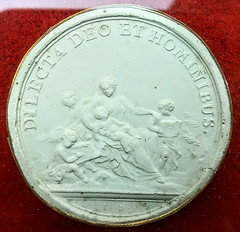
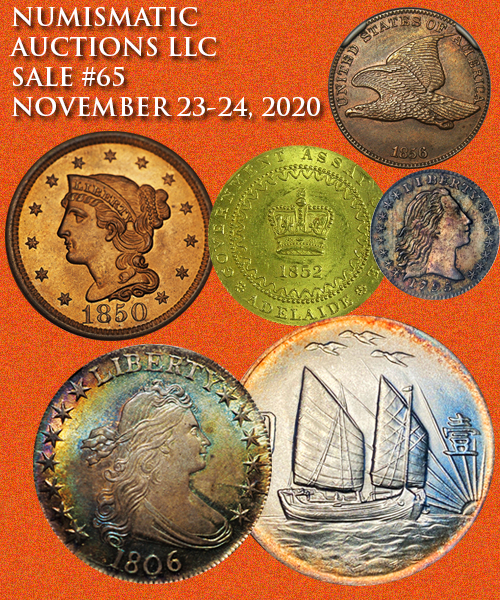
SANDHAM'S COINS, MEDALS AND TOKENS OF CANADA
Howard R. Engel is the proprietor of Richard Stockley Books in Winnipeg, Manitoba, Canada, specializing in numismatic and philatelic literature. He recently inaugurated a new column on literature in Bison Tales, a publication of the Manitoba Coin Club. They and Howard kindly agreed to my request to excerpt the articles here in The E-Sylum. Thanks for sharing this. Items discussed are generally part of Howard's stock. All readers are welcome to do the same, offering a "show-and-tell" about interesting numismatic literature items in their library, duplicate file or stock. -Editor
Engel's Angle on Numismatic Literature
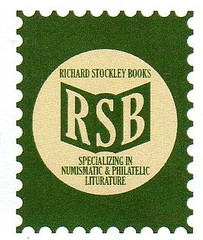 Welcome to a new column about important yet affordable Canadian numismatic literature. Thanks to the Bison Tales editor (who wishes to remain anonymous by request) for inviting me as your friendly neighbourhood antiquarian, used and out-of-print numismatic and philatelic literature dealer (the only one, as far as I know, left in Canada that specializes in these areas) to provide a few words about such important titles currently in my stock. While the idea for this column arose from the editor of Bison Tales, the title "Engel's Angle on Numismatic Literature" came from me, although not entirely. As the Vice-President and General Manager of his family company known (at that time) as Atomic Transfer Ltd., my father, Roland R. Engel, wrote for a column in the Atomic Flash company newsletter (published from 1962 to 1967) called, you guessed it, "Engel's Angle".
Welcome to a new column about important yet affordable Canadian numismatic literature. Thanks to the Bison Tales editor (who wishes to remain anonymous by request) for inviting me as your friendly neighbourhood antiquarian, used and out-of-print numismatic and philatelic literature dealer (the only one, as far as I know, left in Canada that specializes in these areas) to provide a few words about such important titles currently in my stock. While the idea for this column arose from the editor of Bison Tales, the title "Engel's Angle on Numismatic Literature" came from me, although not entirely. As the Vice-President and General Manager of his family company known (at that time) as Atomic Transfer Ltd., my father, Roland R. Engel, wrote for a column in the Atomic Flash company newsletter (published from 1962 to 1967) called, you guessed it, "Engel's Angle".
Naturally the question arose about where to begin with such a rich, varied and long history in Canadian numismatic literature that is, as the Bison Tales editor suspected, quite well-represented by my stock. Why not at the beginning, of organized numismatics in Canada, that is? The first organized numismatic group was the one formed in 1862, five years prior to Canadian Confederation, variously called in more or less chronological order, the Numismatic Society of Montreal, the Numismatic and Archæological Society, Montreal, the Numismatic and Antiquarian Society of Montreal and, latterly, the Antiquarian and Numismatic Society of Montreal that met at the Chateau de Ramezay. This is Canada's oldest public building, built in 1705 by Claude de Ramezay, appointed as the 11th Governor of Montreal in 1703 and briefly occupied, in 1775 by American revolutionary forces, including Ben Franklin and Benedict Arnold and purchased as a site for a museum by the Society in 1895.
It continues to serve as a museum and tourist destination to this day, housing many artifacts documenting the history of Montreal in particular, including one of Canada's most extensive numismatic collections. I paid my first visit (or perhaps more appropriately, "pilgrimage") during the RCNA Convention held in Boucherville, Quebec on the south shore of the St. Lawrence River, next door to Montreal in 2017. Thanks to the Society led by Ludger Gravel, the American Numismatic Association held its first-ever convention in Canada (only one of two) at Chateau de Ramezay in 1909. Although not the primary site of the 1923 ANA Convention in Montreal (thanks again to Gravel and his Canadian ANA committee), it was one of the most popular tour destinations, especially given its rich numismatic history.
 Alfred Sandham (1838-1910) a native Montrealer, has the distinction of publishing Canada's first ever coin book in 1869, Coins, Tokens and Medals of the Dominion of Canada, under the auspices of the Numismatic and Antiquarian Society of Montreal of which Sandham became one of its most active members in 1865 and helped to incorporate the Society in 1870 (exactly 99 years before the Manitoba Coin Club was incorporated in 1969).
Alfred Sandham (1838-1910) a native Montrealer, has the distinction of publishing Canada's first ever coin book in 1869, Coins, Tokens and Medals of the Dominion of Canada, under the auspices of the Numismatic and Antiquarian Society of Montreal of which Sandham became one of its most active members in 1865 and helped to incorporate the Society in 1870 (exactly 99 years before the Manitoba Coin Club was incorporated in 1969).
Sandham was instrumental in getting the Society to strike its first medal commemorating this occasion and its 1862 founding, 42 mm in size in both white metal and bronze and listed as Breton 171 and Leroux 1610.
According to a letter by Sandham found in a copy of his book in 1992 by collector and researcher Barry Uman, only 300 copies of this book were printed, 250 were bound and only 100 sold, which gives an idea about the relatively small size of the organized numismatic community concentrated in Montreal at the time (ca. 1870). Although original copies of this book still exist and only very occasionally turn up on the secondary market (I had the good fortune of picking one such copy up for a song from a Brooklyn, NY antiquarian book dealer earlier this year), they would normally command a much higher price several times that of the 1962 reprint by the Canadian Numismatic Publishing Institute (CNPI) of Winnipeg, my hometown. Thankfully, copies of this reprint are much more readily available.

Sandham, Alfred. COINS, TOKENS AND MEDALS OF THE DOMINION OF CANADA. Winnipeg: Canadian Numismatic Publishing Institute, 1962 reprint. 72, (2) pages; frontispiece; text figures; 8 plates. Fine $40.
Sandham was also the first editor, from 1872 to 1876 of The Canadian Antiquarian and Numismatic Journal, that was published off and on in various series until 1933. Somer James (1921-2005) of the CNPI reprinted Sandham's book a hundred years after the first coin club in Canada was formed in 1862. He also reprinted seminal numismatic works by P.N. Breton, Joseph Leroux and American Colonial History Illustrated by Contemporary Medals by Charles Wyllys Betts. In addition, as the proprietor of Regency Coin and Stamp Co. of Winnipeg, he collaborated with expert photographer Harold Cleveland Taylor (1887-1965), founding Vice-President of the Manitoba Coin Club and great grandfather of our First Vice-President, Ken Dobson, to produce the first 8 editions of A Guide Book of Canadian Coins, Currency and Tokens (1959-1966). Watch this column for more about The Canadian Antiquarian and Numismatic Journal, the original works and reprints of P.N. Breton and Joseph Leroux and the James/Taylor Guide Book, among many other Canadian numismatic treats.
References:
Douglas, Scott E. "The Chateau de Ramezay and the Antiquarian and Numismatic Society of Montreal". The Canadian Numismatic Journal. Vol. 56 no. 2, Mar. 2011, p. 72-75.
Uman, Barry. "Alfred Sandham (1838-1910)". The Canadian Numismatic Journal. Vol. 44 no. 10, Dec. 1999, p. 471-474 and reprinted with colour illustrations in Oct.-Nov. 2017, Vol. 62 no. 7 of CNJ, p. 299-303. [reprinted with excerpt of Alan Roy's The CN Journal article in June 2008 The E-Sylum]
Thanks, Howard! Readers can reach him at 204-253-0419 or by email at richardstockleybooks@mymts.net .
Congratulations Howard on his first anniversary at the helm of Richard Stockley Books! -Editor
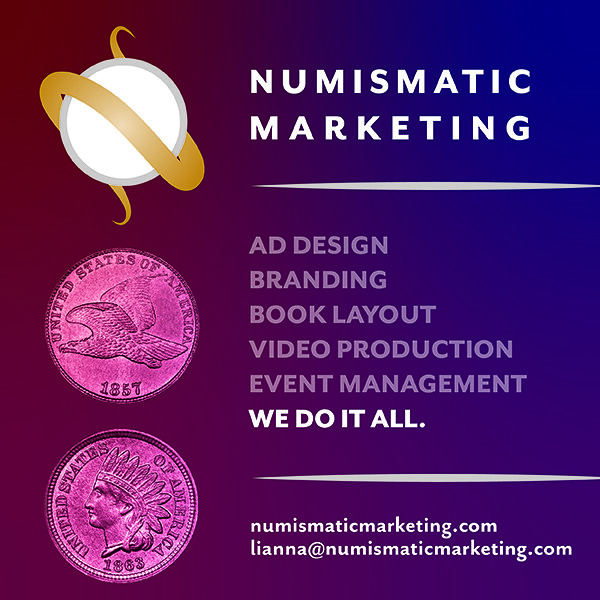
VOCABULARY TERM: NATIONAL MEDAL
Dick Johnson submitted this entry from his Encyclopedia of Coin and Medal Terminology. Thanks. -Editor
National Medal. A medal of national character or interest; a medal struck by a national mint. In the United States "national medals" is a loose term for all the medals produced by the United States Mint at present, but only about half of those of the past. It includes all the medals authorized by U.S. Congress (congressional medals) plus all those sold to the public by the United States Mint (list medals). The term excludes private issue medals (once widely manufactured by the U.S. Mint but which have not been struck since 1956).
The term national medal has legal meaning in that it is mentioned in the United States Code (section 31, paragraph 368). This states that dies for national medals can be executed and the medals struck at the Mint with the approval of the Director, provided production of the medals do not interfere with the production of coins; further, no private dies can be made at the Mint, nor can the machinery in the Mint be used for private purpose.
Nineteenth century. The wording in the current Code is in stark contrast to the situation in the 19th century. For most nations early in their history, private medal presses with the capability to strike large medals just do not exist (it comes with a highly industrial development and a refined cultural need). In most countries the national mint is often the only source where large medals of artistic design can be produced. So it was in the United States as late as the 1890s.
Individuals, and organizations (both governmental and private), had to apply to the Philadelphia Mint as the only American maker of such medallic work. The only medals the U.S. Mint would not strike in the 19th century were political or campaign medals (although this rule was apparently broken for the Mint striking the Lincoln Cabinet Medal, PR-35, in 1964, and the John Charles Freemont Medal, PE-11, in 1863, which had been used during his presidential campaign of 1856). All campaign medals had to be struck by private medal makers. For the most part these were created by diesinkers who did not have presses of great capacity, thus most campaign medals were small diameter, token-like medals.
Left to their discretion, the directors of the mint were fairly liberal in allowing medals of any kind to be produced at the mint. Thus even wedding medals, Sunday school medals, parade medals, dog show and other ephemeral medals were struck at the national mint. These clients had to pay for the cost of making the dies, the blanking and striking, plus the cost of the metal composition (although they would sometimes furnish their own dies, or their own metal!).
About half of all the medals struck by the U.S. Mint from 1792 until 1900 could be considered personal or private, certainly not of a "national character." Whether any medal met the test of national interest was not required during most of the 19th century.
Twentieth century. Since 1892, and early in the 20th century, the rising infant medal industry sought out this business. Private American medal manufacturers grew in the 20th century until there existed ample production facilities available, eliminating the need for the U.S. Mint to strike such pieces.
Private medal manufacturers mounted their most aggressive campaign against the U.S. Mint for striking private medals during the depression in the mid 1930s. Orders had fallen until they had work for only half days. Despite this plea to get the mint out of the business which should have gone to private industry, the U.S. Mint continued.
It accepted private medal orders until 1948 but continued to strike those medals for which they had the dies. Only since 1950 has the definition of national medals been codified to eliminate the striking of personal and private medals by the U.S. Mint. The last such private medal was struck in 1956. See private issue.
References:
O37 {1977} Julian.
Looking for the meaning of a numismatic word, or the description of a term? Try the Newman Numismatic Portal's Numismatic Dictionary at: https://nnp.wustl.edu/library/dictionary
Or if you would like a printed copy of the complete Encyclopedia, it is available. There are 1,854 terms, on 678 pages, in The Encyclopedia of Coin and Medal Technology. Even running two a week would require more than 19 years to publish them all. If you would like an advance draft of this vital reference work it may be obtained from the author for your check of $50 sent postpaid. Dick Johnson, 139 Thompson Drive, Torrington, CT 06790.

S. ARCHIE HAMILTON (1890-1920)
John Lupia submitted the following information from the online draft of his book of numismatic biographies for this week's installment of his series. Thanks! As always, this is an excerpt with the full article and bibliography available online. This week's subject is Iowa paper money dealer Archie Hamilton. -Editor
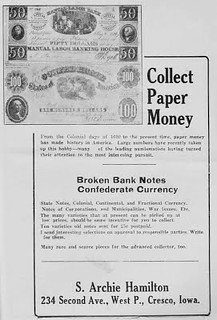 S. Archie Hamilton (1890-1920), was born January 15, 1890, at Cresco, Iowa, son of S. Archie Hamilton, a railroad brakeman, and later on a farmer. He attended Cresco Public School, and graduated Page Davis Advertising School.
S. Archie Hamilton (1890-1920), was born January 15, 1890, at Cresco, Iowa, son of S. Archie Hamilton, a railroad brakeman, and later on a farmer. He attended Cresco Public School, and graduated Page Davis Advertising School.
Hamilton was a paper money dealer from 1915 - 1920 operating his company S. Archie Hamilton Co.
From 1908-1909, he worked for one year in Minneapolis as a printer and returned to Cresco with his own printers shop.
He was a member of the ANA, Chicago Coin Club, Modern Woodman of America, Maple Camp No. 1344.
In April 1918 he was sent to a Modern Woodman Sanitarium, Woodman, Colorado.
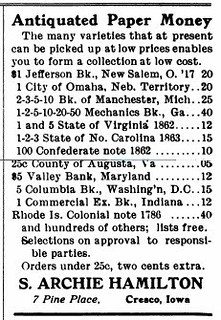

He died of tuberculosis on June 11, 1920 at a sanitarium in Davenport, Iowa. He was survived by his parents and siblings Mabel, Fred, Harry, and George. He is buried in Oak Lawn Cemetery, Cresco, Iowa.
To read the complete article, see:
HAMILTON, ARCHIE
(http://www.numismaticmall.com/numismaticmall-com/hamilton-archie)

HARVEY STACK'S NUMISMATIC FAMILY, PART 80
The latest article in Harvey Stack's blog series covers the 1980 crash in silver prices and its effect on the numismatic market. Thanks, Harvey! -Editor
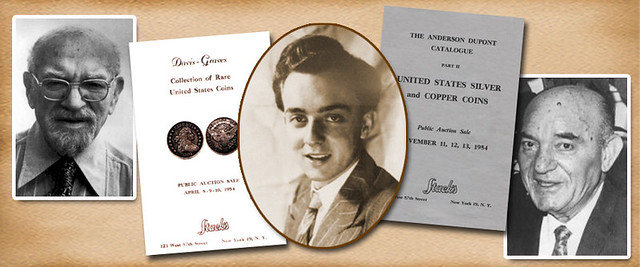
The year 1980 began with a crash in the precious metals silver market. For years, the price and value of silver had risen and as noted before, some people were hoarding it and trying to corner the market. The price increases induced people to search out silver coins that they had in piggy banks, cookie jars and other places and sell them.
In a short period of time, starting in the late months of 1979, the price of silver dropped dramatically from as high as $50 an ounce to $10 an ounce a few months later. And it threatened to drop even lower. As explained earlier, the Hunt family had bought tons of silver, spending millions of dollars and speculating that the price might go as high as $100 per ounce. They bought more on margin and by the later part of 1979 had created a real bull market in silver bullion. With the constant increase in value, banks and traders worldwide followed their lead and bought and speculated in futures on this market.
When some of the loans became due to the Hunts, they initially covered them. But eventually they and other speculators were unable to provide the necessary cash to cover their loan calls. Panicked selling began and silver flooded the market, causing the price to plummet. The constant calls for cash brought the Hunt family to bankruptcy, as it did many others who bought high and were forced to sell low, with many losing over 70% to 80% of their initial investment.
There was a rumor started that the U.S. Mint or Treasury would start buying silver again and re-stimulate the interest, bringing prices back up. But these rumors were not true. This caused a drop in other markets. Industries that had needed silver and had bought it at high prices, sometimes on contract, were now "stuck" with a devalued asset. Havoc was everywhere.
There were many coin buyers who had profited from the run up in silver prices and some who had started investing in coins as part of the silver speculation. This section of the numismatic market quickly changed and those who had been participating in it either left the hobby, sold their collections, or put them away on a shelf or in the bank to see if the market would go back up.
As you can imagine this was not a great time for numismatics, even though dealing in precious metals was only a small part of the coin collecting hobby. However, all the panic in the metals markets and the ensuing publicity brought about a lapse of interest in collecting "numismatic coins." The entire silver episode that the Hunts had initiated beginning a decade earlier had a major effect on the economy for years to come. Their speculation affected the entire economy.
Of course, all of us at Stack's continued to conduct our numismatic business during this period, buying and selling coins and holding public auctions, although prices were not as high for many things. Due to our longevity in the field and our ability to maintain a large diversified inventory, we were able to serve the collectors who still had capital to buy. Running a coin business during these difficult times was not easy, but luckily we had an established clientele, as well as commitments of consignments already set for 1980.
To read the complete article, see:
Harvey Stack Remembers: Growing up in a Numismatic Family, Part 80
(https://www.stacksbowers.com/News/Pages/Blogs.aspx?ArticleID=harvey-stack-remembers-part-80)
To read the earlier E-Sylum article, see:
HARVEY STACK'S NUMISMATIC FAMILY, PART 79
(https://www.coinbooks.org/v23/esylum_v23n39a19.html)
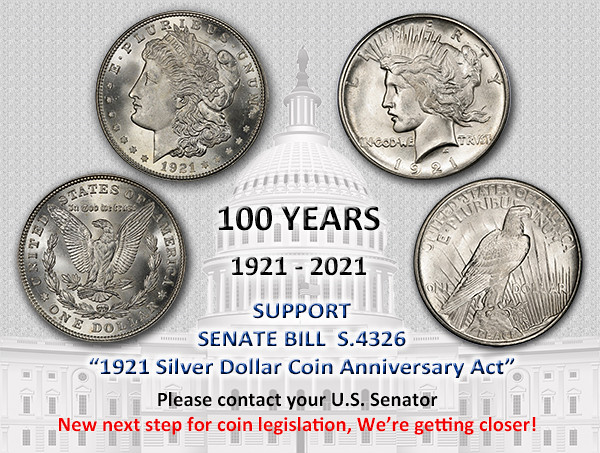
SUBSCRIBER PROFILE: BRIAN HERRIOTT
It's been a while since we've done a Subscriber Profile. Meet Brian Herriott, a collector and dealer of British Conder tokens. -Editor
 My name is Brian Herriott. I am the chap who has jumped into the fray and have been diligently working to acquire our friend Bill McKivor's business, The Copper Corner. Whether I'm the most ideally suited individual to carry out this feat, and be judged equal to the herculean task of filling Bill's shoes, I will leave up to you (and Bill, of course!)
My name is Brian Herriott. I am the chap who has jumped into the fray and have been diligently working to acquire our friend Bill McKivor's business, The Copper Corner. Whether I'm the most ideally suited individual to carry out this feat, and be judged equal to the herculean task of filling Bill's shoes, I will leave up to you (and Bill, of course!)
I am currently 50 years old with a loving wife and two daughters. I currently live in Cincinnati, OH, having moved from Chicago, IL, close to ten years ago. In my former life, I was a somewhat well-received actor/singer on the stage, performing in mostly musical-theatre, plays, and some opera. I did this for 20 years approximately.
As for my relationship with our beloved British tokens, I first discovered them at a coin show in Columbus, OH. There was a dealer with a lone Norfolk Norwich 23 and I thought to myself, "This looks interesting." An affordable copper token from the 18th century, cool design, political message, and in uncirculated condition? Sounded good to me, so I bought it. Upon getting home, I delved into Google and it wasn't long before I was hours into the magical world of what we all call 'Conder' tokens. Having decided I simply MUST have more of these, I searched around for dealers and quickly found my way to Bill McKivor and The Copper Corner.
I soon found that I was no longer interested in finishing my U.S. Gold type set, my Barber dime XF set, or even my beloved collection of coins with birds on them. Well, I still have to get my New Zealand Kiwi silver proof dollars every year, because, well. . . . Kiwis! All I wanted, however, was more Conders!
Fast forward to our present time frame and one of my correspondences with Bill. I asked him somewhat flippantly how he got into the token dealing business. His response was, "You have opened an interesting door." I certainly did! And since that door had been opened, Bill and I have been corresponding almost daily since early September, 2019. I even flew out to Seattle to visit with him and his lovely wife, June, for several days to talk tokens. Had a wonderful time getting to know Bill and be chauffeured around in Kermit, his super fun, and very GREEN, 1950's Kaiser. We had a great three days of studying his token collection, discussing grading, and most importantly, how Bill runs his business. He has always told me that a dealer really owns nothing but their reputation, and to always be honest with your customers. 100% satisfaction. You already know this, of course.
I was assured by Bill that although the learning curve is long, with dedication and perseverance, if a former paper boy could do it, then so could I!
To visit Brian's website, see:
https://druidscache.com/

HISTORY OF ANA'S BEN E. KEITH ENDOWMENT
As part of a press release on their budget for fiscal year 2020-21, the American Numismatic Association provided some background on the Ben E. Keith stock that fuels the organization's endowment. -Editor
History of the Ben E. Keith Company Stock Endowment
 Kenneth Keith of Jolly and Wichita Falls, Texas, was the nephew of Ben E. Keith and an heir to the food-and-beverage company bearing his uncle's name. He also was an avid numismatist. In July 1975, five men broke into Kenneth Keith's home, which he shared with his brother Jim, in search of a valuable coin collection that, unbeknownst to the burglars, had been donated to the American Numismatic Association's Money Museum in 1971. Jim was killed during the armed robbery, while Kenneth was beaten and bound. The ANA posted a reward for the capture and conviction of the men, who were later apprehended and convicted of murder. In 1976 Kenneth Keith set up his will naming the ANA one of the remainder beneficiaries to his shares of stock in the Ben E. Keith Company, a closely held business that is a leading food-and-beverage distributor, serving customers across dozen-plus U.S. states. Kenneth Keith died the following year.
Kenneth Keith of Jolly and Wichita Falls, Texas, was the nephew of Ben E. Keith and an heir to the food-and-beverage company bearing his uncle's name. He also was an avid numismatist. In July 1975, five men broke into Kenneth Keith's home, which he shared with his brother Jim, in search of a valuable coin collection that, unbeknownst to the burglars, had been donated to the American Numismatic Association's Money Museum in 1971. Jim was killed during the armed robbery, while Kenneth was beaten and bound. The ANA posted a reward for the capture and conviction of the men, who were later apprehended and convicted of murder. In 1976 Kenneth Keith set up his will naming the ANA one of the remainder beneficiaries to his shares of stock in the Ben E. Keith Company, a closely held business that is a leading food-and-beverage distributor, serving customers across dozen-plus U.S. states. Kenneth Keith died the following year.
The Ben E. Keith Company, one of the largest Anheuser-Busch InBev distributors in the nation, is listed by Forbes as the 121st largest privately held company in the United States.
Regarding the museum donation, I checked with the ANA's Edward C. Rochette Money Museum Director Doug Mudd, who writes:
"The collection was primarily of Mexican colonial coins and medals and a few Canadian coins and consisted of one main donation of several hundred coins in 1971 and then several other small donations over the next few years that included some US colonial notes (a dozen or so) along with Mexican and Canadian counterfeits. There are some nice pieces in the donation - the most notable being two rare Mexican colonial 3 real coins - one corroded and one in much nicer condition."
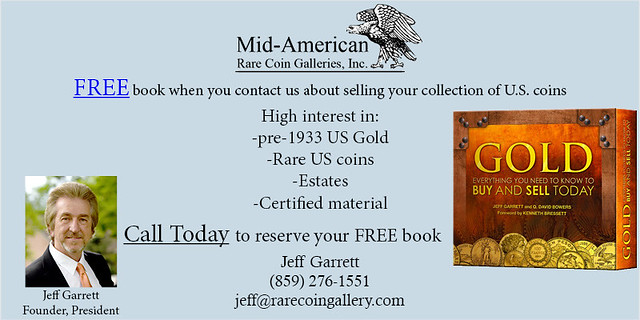
WRITING A GUIDE BOOK OF COLLECTIBLE POSTCARDS
How does Dave Bowers do it? He has a superhuman capacity for writing one great book after another. In this article about Dave's latest work, Dennis Tucker provides some insights. Thanks! -Editor
The Postcard Hobby of Bowers and Martin: "An Interesting Field of Interesting People Collecting Interesting Things"
by Dennis Tucker, publisher, Whitman Publishing, LLC
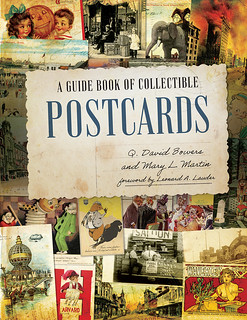 Like many hobbyists, I've read Q. David Bowers's books since I was a young collector. For more than fifteen years I've also had the honor of being his publisher, adding many new works to his extensive oeuvre. As for Mary L. Martin, I've known of her for almost as long—Dave sings the praises of Mary's parents, and of Mary herself, as experts in the field of postcards. It was an honor to finally meet her in person a few years ago, at her shop in Havre de Grace, Maryland, as the three of us discussed their latest collaboration, the 432-page Guide Book of Collectible Postcards.
Like many hobbyists, I've read Q. David Bowers's books since I was a young collector. For more than fifteen years I've also had the honor of being his publisher, adding many new works to his extensive oeuvre. As for Mary L. Martin, I've known of her for almost as long—Dave sings the praises of Mary's parents, and of Mary herself, as experts in the field of postcards. It was an honor to finally meet her in person a few years ago, at her shop in Havre de Grace, Maryland, as the three of us discussed their latest collaboration, the 432-page Guide Book of Collectible Postcards.
Early in the planning process for this book, Dave shared some letters written between himself and a well-known postcard collector: Andreas Brown, president of the famous salon-like Gotham Book Mart (West 47th Street in Midtown Manhattan's Diamond District). Dave had invited Brown's feedback on a manuscript he was preparing on the postcards of Alphonse Mucha. Their letters back and forth are a fascinating exploration of grading, rarity, market values, buying and selling—every aspect of the postcard hobby, "an interesting field of interesting people collecting interesting things," as Dave put it in one letter.
Those letters illustrate that Dave Bowers is neither a newcomer to the hobby, nor a dilettante. They were written in 1980. His coauthor on the Alphonse Mucha book was Mary L. Martin the elder—mother of his current collaborator.
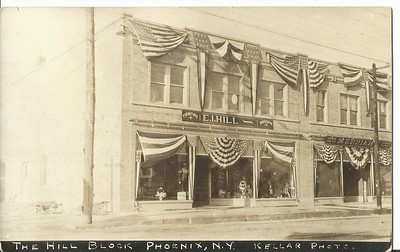
Historical postcard from Whitman publisher Dennis Tucker's hometown of Phoenix, New York, dating from the early 1900s.
Collectors of coins, paper money, medals, and tokens have known Dave Bowers as a prolific researcher and writer since the 1960s. Some also know he's written authoritative references on other interests, such as automatic music machines and early silent-film history.
Over the years as Dave's publisher at Whitman Publishing, I've often been asked, "How does he write so many books?"
First of all, as Isaac Asimov and other productive authors have said, "A writer writes"—and Dave has been doing this for more than fifty years. But what he does is multi-faceted and immersive, more than the simple (but important) physical act of sitting down at a desk and putting pen to paper.
The cornerstone of his system is the Bowers archives. Long before the Internet, Dave was compiling a personal library and research center of books, newspapers, magazine clippings and snippets, and other resources—anything and everything relating to his scholarly interests. He read and studied decades' worth of old periodicals and made note of everything relating to, for example, postcards, collecting in the Golden Age, the intricacies of printing and distribution, Post Office procedures, and more.
As technology has advanced, so has the Bowers research machine. Historical images that he earlier had to clip, photograph, or photocopy can now be scanned and saved digitally in high resolution. Instead of having to travel to faraway museums and archives, email and the Internet put him in a hundred places at once, with instant communications.
This touches on another important factor in how Dave Bowers works: collaboration. "To have a friend, you must be a friend," as the saying goes. Over a career that has spanned decades, he has built a reputation as a researcher who generously shares information instead of jealously guarding it. In return, other scholars share their own specialized insight—and Dave absorbs and synthesizes it as only he can, to then give to his readers.
Another element of the Bowers method is a constant and never-resting spirit of inquiry that spans genres, disciplines, and fields. Dave is as curious a student of current events as he is of the past. His book subjects run up and down the Dewey Decimal System. The hobby community is fortunate that postcards captured his imagination early on, and have never let go.
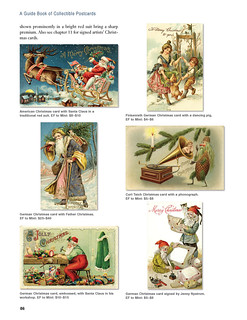
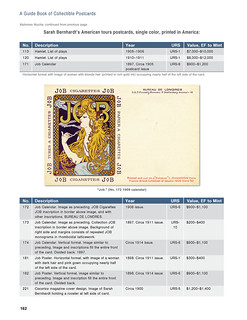
For the Guide Book of Collectible Postcards, the foundation of the manuscript was the knowledge Dave Bowers has been gathering over many decades as an active collector and historian. His partner in building on that foundation needs no introduction to postcard collectors. Mary Martin is the owner and operator of the biggest postcard dealerships and shows in the United States (quite possibly the world?), and an accomplished researcher in the field. She has authored, coauthored, or edited some fifty books on the subject of postcards. When I visited her Maryland shop in 2018, her inventory numbered in the millions of cards, dating back to the art form's Golden Age (the 1890s through World War One).
Mary collaborated on the outline of the Guide Book, reviewed Dave's research, and provided hundreds of high-quality scanned images. She marshaled her extensive knowledge of the market to provide valuations for the 1,300-plus cards illustrated, and values for hundreds of card types, varieties, and topics.
As famous collector Leonard Lauder observed in his foreword to the 2016 Bowers/Martin book The Postcards of Alphonse Mucha, "Postcard collectors value the hunt." Every hunter benefits from a good guide, and the new Guide Book of Collectible Postcards leads the way.
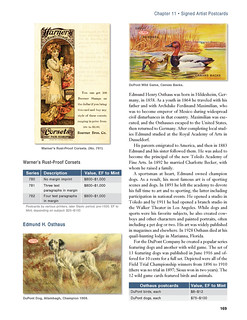 Not simply a useful reference, the new volume will appeal to multiple and diverse audiences. Students of art, history, advertising, and related fields find the Guide Book interesting and informative. Fans of Art Nouveau, American comics, and vintage photography enjoy a gallery of outstanding works. Active hobbyists benefit from the valuation charts, detailed catalogs, and check lists. These resources give a blueprint to follow while building your collection, as well as a guide to valuing and analyzing cards you already possess. The bibliography, glossary, appendices, and indexes add to the book's already impressive utility.
Not simply a useful reference, the new volume will appeal to multiple and diverse audiences. Students of art, history, advertising, and related fields find the Guide Book interesting and informative. Fans of Art Nouveau, American comics, and vintage photography enjoy a gallery of outstanding works. Active hobbyists benefit from the valuation charts, detailed catalogs, and check lists. These resources give a blueprint to follow while building your collection, as well as a guide to valuing and analyzing cards you already possess. The bibliography, glossary, appendices, and indexes add to the book's already impressive utility.
These diverse and well-crafted facets—educational and artistic, collector-oriented, market-savvy, and historical—combine to make Guide Book of Collectible Postcards a delightful and valuable addition to every bookshelf. I'm proud to have worked on it, and I hope you enjoy it.
Dennis Tucker is the publisher of Whitman Publishing; and numismatic specialist in the U.S. Treasury Department's Citizens Coinage Advisory Committee. He is a longtime collector of postcards and has written articles for Postcard World magazine.
A Guide Book of Collectible Postcards
By Q. David Bowers and Mary L. Martin; foreword by Leonard A. Lauder
ISBN 0794847374
Softcover, 8.5 x 11 inches
432 pages
Full color
Retail $39.95 U.S.
https://whitman.com/a-guide-book-of-collectible-postcards/
To read the earlier E-Sylum article, see:
NEW BOOK: A GUIDE BOOK OF COLLECTIBLE POSTCARDS
(https://www.coinbooks.org/v23/esylum_v23n36a07.html)

THE 1860 SNOWDEN MINT BOOK COLLECTION
Now here's the story of someone who really took to heart the classic advice to "Buy the Book Before the Coin", setting out to collect examples of coins mentioned in Snowden's 1860 book on the collection of the U.S. Mint! Allan Davisson published the following in an October 8, 2020 email to clients about his firm's upcoming E-Auction 27. With permission, we're republishing it here. Thanks! -Editor
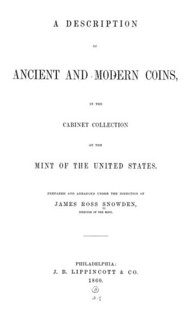 It all started with cattle. If you wanted to barter, you could just herd your payment over for the trade. Oxen were the standard for barter before the Greeks found that refining and minting precious metals at standardized weights and fineness was a much more efficient means of exchange.
It all started with cattle. If you wanted to barter, you could just herd your payment over for the trade. Oxen were the standard for barter before the Greeks found that refining and minting precious metals at standardized weights and fineness was a much more efficient means of exchange.
This somewhat wry discussion opens an 1860 publication by James Snowden, Director of the Mint, A Description of Ancient and Modern Coins in the Cabinet Collection at the Mint of the United States. It is a 400+ page volume filled with history, lists, and descriptions.
The Mint collection, begun in 1838, was formed from foreign coins held as deposits (and saved from the melting pot) as well as purchases authorized by Congress beginning in 1839 with an appropriation of one thousand dollars "for specimens of ores and coins to be preserved at the Mint." Snowden notes that Congress would have appropriated more if asked but "it was deemed expedient 'to set an example of moderation in a pursuit which has its temptations to extravagance and excess.'"
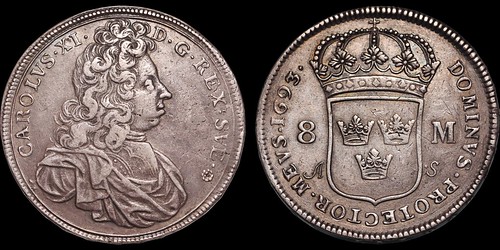
Lot 174
This reference inspired the substantial collection that we are introducing in this catalog—a multi-box assemblage of coins attributed by Krause number. The collector's goal was to represent the mostly post-1600 European world sections of Snowden's works by seeking examples of all the silver and base metal coins mentioned. Lots 167 to 186 represent the Swedish portion of the collection and a smattering of additional material provides a preview of other sections. The collection is "above average circulated" coins emphasizing types connecting to the day-to-day lives of the people who used this currency.
Putting an order to all this so that we can present it in our catalogs is challenging. While an obvious starting point is individual coins of enough interest and value to catalog as single items, the harder question is how to offer the inexpensive but still historically important lesser pieces. We have put them in lots that are estimated very conservatively with enough description that you should have a clear sense of what to expect. We can ship lots for viewing for the cost of Priority shipping. For print catalog readers, we can send a black-and-white photo of the images that are available online.
While the rest of the catalog speaks for itself, the early Roman Imperial bronze collection deserves a mention. It was built by an informed American collector in Minnesota in the early 1950s. He bought coins from Spink and Glendining's corresponding with Leonard Forrer and William French. In the US he dealt with Edward Gans at Numismatic Fine Arts in New York as well as with Earle K Stanton in Los Angeles and Paul S. Seitz in Pennsylvania.
For more information, see:
https://davcoin.com/
To read the book on the Newman Numismatic Portal, see:
A description of ancient and modern coins, in the cabinet collection at the Mint of the United States
(https://nnp.wustl.edu/library/book/512603)

COLTRANE COLLECTION SELECTIONS PART 1
Stu Levine, Bruce Hagen, and Maureen Levine submitted this preview of paper money lots in the upcoming Heritage sale of the Mike Coltrane Collection, Part 1. Thanks! Great notes! -Editor
The Mike Coltrane Collection Part 1 Sale
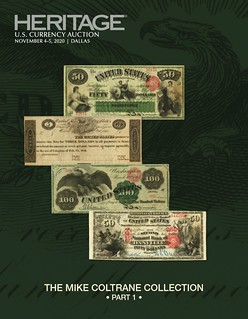 Currency collectors will not want to miss The Mike Coltrane Collection Part 1, to be sold
unreserved by Heritage Auctions on November 4–5, 2020. This event offers outstanding
opportunities for bidders to obtain many choice and interesting United States currency notes,
most of which have been off the market for decades and are offered certified for the first
time.
Currency collectors will not want to miss The Mike Coltrane Collection Part 1, to be sold
unreserved by Heritage Auctions on November 4–5, 2020. This event offers outstanding
opportunities for bidders to obtain many choice and interesting United States currency notes,
most of which have been off the market for decades and are offered certified for the first
time.
An engaging narrative of American currency issues unfolds within this presentation ranging from Colonial issues to the small size currency we currently use. Noteworthy is the first part of Mike Coltrane's War of 1812 Treasury Notes — the most comprehensive ever assembled and cataloged for sale. Numerous Federal currency rarities from all series are featured alongside hundreds of other large and small size type notes in attractive, collector-quality grades. There is something to suit every budget, whether large or small, in this sale.
Some Highlights Include:


Fr. MA-87.1 Massachusetts 1740 Silver Bank 2 Shillings 6 Pence PMG Very Fine 30 Net Ex: F.C.C. Boyd — Exceedingly rare and last auctioned in Ford Part III, May 2005. Lot 25005.
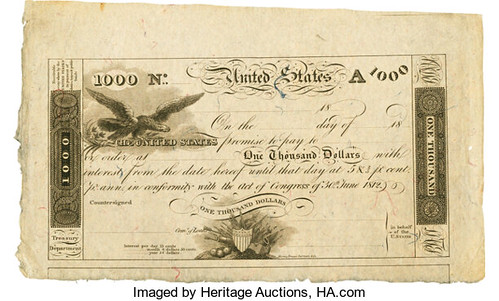
Fr. TN-1 $1000 Act of June 30, 1812 5-2/5% Interest "War of 1812" Unsigned Remainder PMG Choice Uncirculated 63 EPQ — The finest of three examples known. Lot 25015.
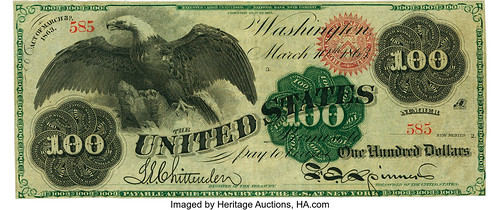
Fr. 167a $100 1863 Legal Tender "Spread Eagle" PMG Choice Very Fine 35 — Rare and well pedigreed. Lot 25105.
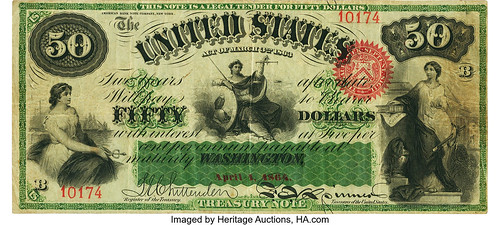
Fr. 203 $50 Act of March 3, 1863 Interest Bearing Note PMG Very Fine 30 — Ex: Anderson- Bass-Schermerhorn and one of seven in private hands. Lot 25111.
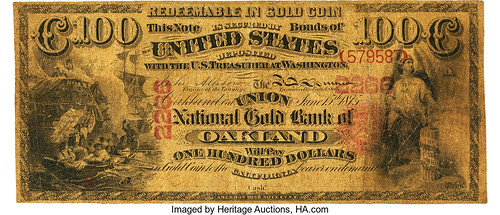
Fr. 1166 $100 Union National Gold Bank of Oakland, California 1875 Ch. 2266 PMG Choice Fine 12 Net-Unique and with an Outstanding Pedigree. Lot 25248.
All lots are currently on Heritage Auctions preview at HA.com/3575a. The sale will be held in Dallas with Session 1 (floor) on November 4 and Session 2 (online only) on November 5. Preliminary lot viewing will be held by appointment only in New York City (October 14-16); for further information contact Sarah Miller at SarahM@ha.com or 214-409-1597. Lot viewing will be available by appointment only at Heritage's Office in Dallas (October 26- November 4); contact Jose Berumen at JBerumen@ha.com or 214-409-1299.

DIX NOONAN WEBB OCTOBER 2020 BANKNOTE SALE
Here's the announcement for this month's Dix Noonan Webb banknote sale. -Editor
BANKNOTE SALE TO DATE
- A spectacular Bank of England Note from 1863 highlights the sale -

A spectacular Bank of England £5 note dating from 28 December, 1863 is among the highlights of an online/ live auction of British, Irish and World Banknotes at Dix Noonan Webb, the international coins, medals, banknotes and jewellery specialists, on Wednesday, October 28, 2020 on their website www.DNW.co.uk. Probably the finest quality early black and white note the cataloguer has ever seen, it is signed by Matthew Marshall and is estimated at £10,000- 12,000 [lot 165].
As Andrew Pattison Head of Department, Banknotes at Dix Noonan Webb, explains: "when it was printed in 1863, this Marshall £5 represented the absolute height of Victorian technology. All of the recent advances in paper making, printing and watermarking, are all clearly visible in this beautiful banknote. In fact, this exact design was used until 1956 - a further 93 years and the fact that it has survived in this condition - almost as if it had been printed yesterday - is miraculous."
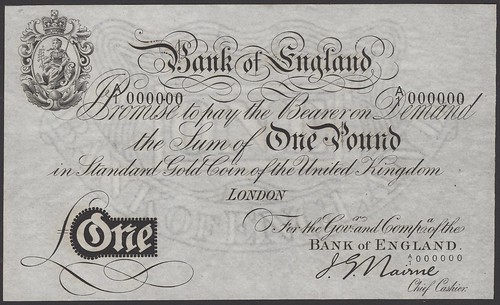
Another important Bank of England note in the sale is a £1 'Gold Note' dating from 1914, signed by John G. Nairne. With the serial number A/1 000000, this is an exceptional uncirculated example of this rare proof type - one of around only 15 to survive today - and carries an estimate of £6,000- 7,000 [lot 168].

The sale of 1060 banknotes includes examples from all over the world. One of the finest known examples of a Qatar & Dubai 100 Riyal - almost uncirculated and a classic rarity in this kind of condition is estimated at £9,000-12,000 [lot 977], while from the Government of Iraq, an impressive 100 Dinars note from 1936, with a magnificent portrait of King Ghazi is expected to fetch £10,000-15,000 [lot 817].
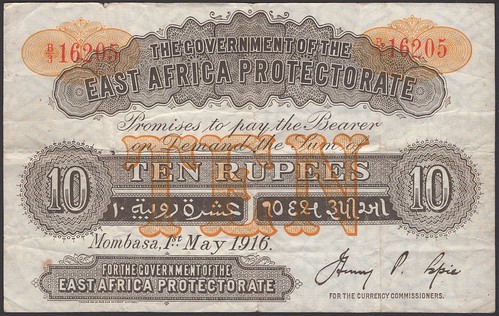
Elsewhere, from the Imperial Bank of Persia, is a wonderful and very fine example of a popular and rare denomination - the 3 Toman note dating from 2 July 1914, which is estimated at £4,000-£5,000 [lot 978]. A rare and interesting fully issued 50 Dalere from the Danish West Indies, with six signatures, dated 1849 is expected to fetch £3,200- 3,800 [lot 728]; while a large and impressive 10 Rupees issued by the East African Currency Board in 1916, in lovely original condition is estimated at £3,400-4,000 [lot 731].
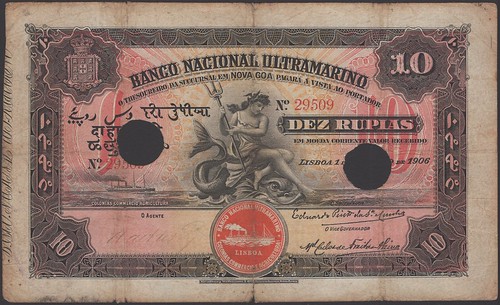
A huge range of Portuguese and Portuguese colonial notes from all eight colonies, including some significant rarities will also be offered. From the Banco Nacional Ultramarino, Portuguese India, is a cancelled 10 Rupias, dating from 1 January 1906, with two large cancellation holes and blue bank handstamp on reverse (est: £2,000-2,600) [lot 964].

Among the British regional banknotes is an unissued £1 note from the Petersfield Bank. The note bears the names of bankers Austen, Blunt & Clement - the Austen in question being Henry Thomas Austen, the brother of author Jane Austen. It is estimated at £300- £400 [lot 106].
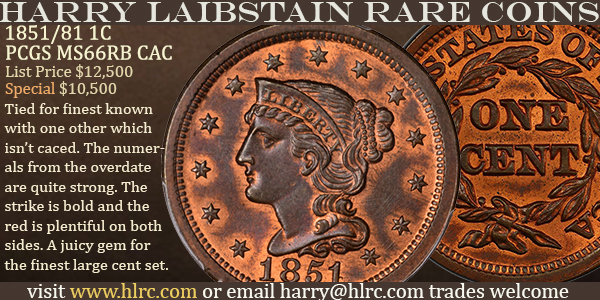
NUMISMATIC NUGGETS: OCTOBER 11, 2020
Here's a selection of interesting or unusual items I came across in the marketplace this week. Tell us what you think of some of these. -Editor
Gaius Caligula for Agrippa
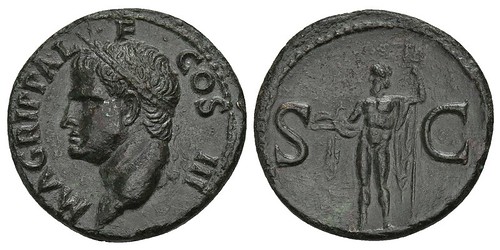
Gaius Caligula, 37-41 für Agrippa.
Æ-As, Rom; 11,23 g. Kopf l. mit Rostralkrone//Neptun steht l. mit Delphin und Dreizack. BMC 161 (Tiberius); Coh. 3 (Agrippa); RIC² 58. Revers etwas korrodiert und geglättet, gutes sehr schön
A strong bust on a nicely centered coin. From the upcoming Künker eLive Auction 62 -Editor
To read the complete lot description, see:
Gaius Caligula, 37-41 für Agrippa.
(https://elive-auction.de/lose/95552?auktion_id=83&order=losnummer.asc&seite=index)
Philip II Tetradrachm

Eastern Celts. Philip II types.
Tetradrachm (silver). Vs: head of bearded Zeus with laurel wreath on the right. Rs: Naked youth with palm branch on horseback riding to the right; under the horse a bundle of lightning, between the front hooves a torch. 24 mm. 12.82 g.
Another nice ancient. -Editor
To read the complete lot description, see:
Lot 8. Eastern Celts. Philip II types.
(https://www.sixbid.com/de/solidus-numismatik/7848/keltische-mnzen/6417233/ostkelten-philippos-ii-typen)
Libertas Americana Medal
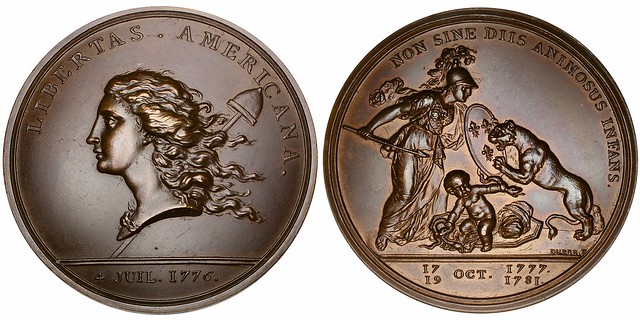
Designed in part by Benjamin Franklin, the popular "Libertas Americana" motif was thought of as emblematic of the fledgling, newly-established nation—wild and untamed, hopeful and, most importantly, free. Here, the allegorical Liberty exhibits free-flowing, unkempt hair, while a Phrygian cap—an ancient symbol throughout Thrace and Anatolia that later came to represent liberty—tops a pole over her shoulder. Continuing on as an iconic piece of iconography from early America, the design has been featured sporadically since, with the Paris mint offering copies utilizing the dies beginning with the bicentennial festivities in 1976, and various issues since in gold, silver, and bronze. While the more recent offerings feature thicker lettering and an antiquing that "feels" modern, early issues such as this are much more faithful reproductions of the original design, with more intricate detail and natural surfaces.
While "only" a 1980s reproduction, I'm not surprised that this gorgeous piece I noticed in Jeremy Bostwick's Numismagram inventory was sold before I could publish this issue. Great medal. -Editor
To read the complete lot description, see:
101315 | UNITED STATES & FRANCE. Libertas Americana bronze Medal
(https://www.numismagram.com/product-page/101315)
1781 Escape of the Dutch Fishing Fleet Medal


1781 Escape of the Dutch Fishing Fleet Medal. Betts-574, Van Loon Supp., 554. Silver. Reverse 2. MS-62 PL (NGC).
31.5 mm. An outstanding example of the type, both sides are fully prooflike in finish, and readily appreciable as such in the absence of all but the lightest iridescent silver toning. Sharply struck with generally wispy handling marks precluding a Choice Mint State grade, although accuracy compels us to mention a couple of thin grazes in the upper obverse field close to the ship's rigging. This is a fascinating medal, commemorating the arrival of Jacob Van der Wint and his sailboat De Roode Roos (the Red Rose) at the Doggersbank in the North Sea, where the Dutch fishing fleet lay unaware that England had just declared war on the Netherlands. Van de Wint (also spelled Van de Windt) was something of a Dutch Paul Revere, letting the fishermen know that the British were coming and allowing them to return safely to port in January 1781. John W. Adams has discovered that this medal is actually known with two different reverses. This specimen uses what he calls "Reverse 2," identical to two Ford specimens and easily identifiable by the letter A in A.V.B. left of the digit 7 in the date 1781. The other variety, where the A is under the 7, was used to strike the LaRiviere and Adams specimens that we have also handled in past sales.
Great medal! Coming up in the November Stack's Bowers sale. -Editor
To read the complete lot description, see:
1781 Escape of the Dutch Fishing Fleet Medal. Betts-574, Van Loon Supp., 554. Silver. Reverse 2. MS-62 PL (NGC).
(https://auctions.stacksbowers.com/lots/view/3-ON0ZZ/1781-escape-of-the-dutch-fishing-fleet-medal-betts-574-van-loon-supp-554-silver-reverse-2-ms-62-pl-ngc)
1871 David Rittenhouse Medal
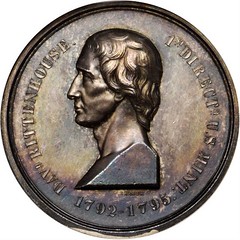
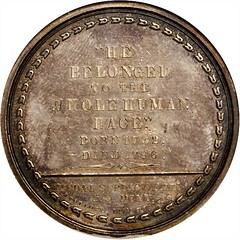
1871 David Rittenhouse Medal. By William Barber. Julian MT-1. Silver. MS-62 (NGC).
46 mm. This is a simply outstanding example of an elusive and historically significant type. Prooflike fields support satiny design elements, the obverse richly toned in iridescent olive-gray with pretty golden-apricot, salmon pink and cobalt blue undertones. The more lightly patinated reverse is dressed in light golden-olive iridescence that appears to drift toward the border. Sharply struck with only minor handling marks precluding a higher grade.
Part of James Pollock's earnestly desired Medal Series of the U.S. Mint, this type is avidly sought by collectors today in honor of Rittenhouse's role in producing America's earliest coinage. Silver impressions are quite rare and, indeed, this is our first offering in this fabric in many years. According to our consignor, the American Philosophical Society has a letter of transmittal for their Rittenhouse medal, from the Mint's Chief Engraver William Barber and dated May 15, 1871, noting the American Philosophical Society bust of Rittenhouse was used as a model.
Another super medal, also from the November Stack's Bowers sale. -Editor
To read the complete lot description, see:
1871 David Rittenhouse Medal. By William Barber. Julian MT-1. Silver. MS-62 (NGC).
(https://auctions.stacksbowers.com/lots/view/3-ON1R2/1871-david-rittenhouse-medal-by-william-barber-julian-mt-1-silver-ms-62-ngc)
Two Interesting Notes
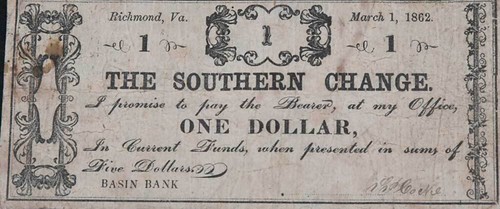

"Invade Cuba!" stamped Silver Certificate, Bay of Pigs reference; Short Snorter on Silver Certificate, some signatures legible; "The Southern Change" banknote, Richmond, 1862, issued by Sylvester P. Cocke; Confederate Poem on T-61 Confederate $2 note
These two notes caught my eye in a group lot at an October 23, 2020 Brunk Auctions sale. I used to collect Civil War era scrip notes, and the one dollar denomination is unusual - most were denominated in fractions of a dollar. And I've never seen a note with the INVADE CUBA overstamp. -Editor
To read the complete lot description, see:
603
GROUP OF FOUR ECLECTIC BANKNOTES
(https://www.brunkauctions.com/lot/group-of-four-eclectic-banknotes-4033790)
THE BOOK BAZARRE
GOLD IDES OF MARCH COIN OFFERED
Roma Numismatics is auctioning a rare gold Brutus aurius, the famous "Ides of March" coin. Here's an excerpt from the lot description. -Editor
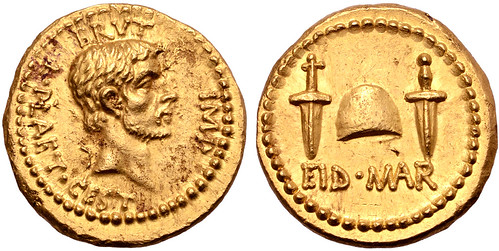
From the collection of the Baron Dominique de Chambrier, original attestation of provenance included; Ex collection of Bernard de Chambrier (1878-1963) and Marie Alvine Irma von Bonstetten (1893-1968); Ex collection of the Baron Gustave Charles Ferdinand von Bonstetten, Chamberlain to Ferdinand I, Emperor of Austria.
Marie Alvine Irma von Bonstetten was daughter of Gustave August Arthur Albert von Bonstetten (1864-1935), the founder of the 'Automobile Club Suisse' in 1898, and great-niece of Gustave Charles Ferdinand von Bonstetten (1816-1892), who was a distinguished antiquarian and collector who published many articles in the Recueil d'antiquités suisses (1855, 1860 and 1867) and L'Essai sur les dolmens (Geneva, 1865), an authoritative study on European dolmens erected between the 5th millennium BC and the end of the 3rd millennium BC. Later, Gustave Charles Ferdinand von Bonstetten worked as an independent researcher and carried out archaeological excavations in both Switzerland and France. In 1873 he donated a part of his important collection to the 'Antiquarium of Bern' and his collection formed the basis of the Bernisches Historisches Museum. The Musée Romain of Avenches also owns pieces from his collection.
Nothing resonates so deeply with those knowledgeable in ancient Roman coinage as the dramatic EID MAR type struck by Brutus in 42 BC, nor indeed is any type more sought after by connoisseurs. Herbert A. Cahn's 1989 study entitled Eidibus Martiis noted 56 examples in silver and 2 in gold. Anecdotal comments have long suggested the extent of the surviving population of EID MAR denarii could approximate as many as a hundred specimens - a reasonably high figure for what is considered to be an extreme rarity – and Campana's as yet unpublished Die Study indeed identifies 88 examples (at last count) in silver (of which at least 34 are now in institutional collections) and 3 in gold. On account of its enormous historical importance and enhanced by its virtual unobtainability to all but the most fortunate of collectors, this coin type like no other has inspired great admiration, fascination, disbelief and desire in the hearts of historians, numismatists and collectors.
Foremost of the reasons for the exalted position of the type in the collective consciousness is its naked and shameless celebration of the murder of Julius Caesar two years earlier in 44 BC. This brutal and bloody assassination had been prompted by the well-founded belief among the Senate that Caesar indented to make himself king, which in truth he was already in all but name. By special decree of the Senate Caesar had been made dictator perpetuo - dictator in perpetuity - and granted the extraordinary and unprecedented honour of striking coins bearing his own likeness, thus breaking the ancient taboo of placing the image of a living Roman upon a coin. By these and other affronts to the traditional values and institutions of the Republic did Caesar seal his fate. On 15 March, 44 BC, in a room adjoining the east portico of the Theatre of Pompey, Caesar was stabbed twenty three times by the gang of Senators numbering over thirty and perhaps as many as sixty, men that Caesar called his friends, and of whom many had been pardoned by him on the battlefield and now owed their ranks and offices to him. The simple but bold reverse design employed by Brutus for this aureus contains the three principal elements of this 'patriotic' act of regicide committed to liberate the Republic from monarchical tyranny. Most striking are the two daggers of differing design, the one symbolising that wielded by Brutus himself, the other that of Cassius his co-consipirator. These flank the pileus, the cap of Liberty as worn by the divine twins and patrons of Roman armies Castor and Pollux, and which was conferred upon all freed slaves as a mark of their emancipation. The legend EID MAR is the abbreviation of EIDIBVS MARTIIS – the Ides of March. Thus, in an act of unparalleled braggadocio, we are at once presented with the murder weapons used to slay Caesar, the precise date of the deed, and the motive.
To read the complete lot description, see:
Brutus AV Aureus.
(https://www.romanumismatics.com/221-lot-463-brutus-av-aureus?auction_id=75&view=lot_detail)
Dick Hanscom forwarded a news article about the coin; I added a second one. Thanks. This could be a headline-making hammer price. -Editor
A previously unrecorded example of a valuable ancient "Ides of March" gold coin commemorating the assassination of Roman dictator Julius Caesar in 44 B.C. has been confirmed by rare coin authenticators in the United States and the United Kingdom. Experts describe it as "a masterpiece."
"It was made in 42 B.C., two years after the famous assassination, and is one of the most important and valuable coins of the ancient world. The front has a portrait of Marcus Junius Brutus, one of Caesar's assassins, and the other side dramatically has two daggers and the words EID MAR, a Latin abbreviation for Ides of March," explained Mark Salzberg, Chairman of Numismatic Guaranty Corporation (www.NGCcoin.com) in Sarasota, Florida, the company whose experts who confirmed its authenticity.
Though nearly 100 Ides of March coins made in silver are known, this is only the third example known in gold. Of the other two, one is in the British Museum on loan from a private collector and the other is in the Deutsche Bundesbank collection.
"There were rumors of a third example and NGC authenticators were excited when this coin was submitted at our London office and sent for evaluation at our headquarters in Sarasota, Florida," said Salzberg.
To read the complete articles, see:
Julius Caesar "assassination coin" may be worth millions
(https://artdaily.cc/news/128927/Julius-Caesar--assassination-coin--may-be-worth-millions#.X4NVVWhKhPZ)
Rare 2,000-year-old Roman gold coin commemorating the assassination of Julius Caesar is expected to fetch 'up to £5 MILLION' at auction in London
(https://www.dailymail.co.uk/sciencetech/article-8820045/Rare-2-000-year-old-Roman-gold-coin-expected-fetch-5-MILLION-auction-London.html)

DELIBERATELY DAMAGED COINS AND TOKENS
David Powell submitted these notes about articles on the topic of deliberately damaged coins and tokens. Thanks! -Editor
With reference to last week's E-Sylum article on deliberately damaged Celtic coins, there are three types of British tokens which I believe were sometimes deliberately defaced:
- 17th cent copper and brass tokens of the period 1648-72.
- Crude lead tokens.
- Communion tokens.
I have written a whole article on this in edition 59 of my lead token newsletter {Leaden Tokens Telegraph, or LTT}, and there is another, on communion tokens specifically, on pages 3-4 of edition 29. The main purpose of this mutilation was as an invalidation mark, to indicate that the piece was no longer current, although in the case of communion tokens mutilations of different types were sometimes applied to the pieces of the same basic design as a form of differentiation.
It is very possible that invalidation marks may have been applied to other series, including coins, after they had been declared obsolete.
Thanks! Here's an excerpt from the Damaged Communion Tokens article. -Editor
In some of the Scottish churches which issued communion tokens, it was found administratively convenient to do so from a number of tables, scattered around the church, and to direct the congregation to specific tables so as to ensure an even distribution and optimum flow. The usual method of doing this was to counterstamp the token, either on the back if it was uniface, or in a space left in the main design specifically for the purpose. A minority of table-numbered pieces have the digit struck as part of the design, as per the rest of the detail, although these tend to be more in the post-1843 white metal period than in the crude lead days; one disadvantage of pre-striking being that the church was stuck with what pieces it had, and lost the advantage of being able to counterstamp selectively.
One would think that it was the larger city churches which found the greater need to indulge in such practices, but it was not necessarily the case; some of what you would think were quite modest rural parishes seemed to find the need for more tables than you would have thought. The frequency of table number obviously decreases as the table number increases; the highest number observed on a token is 13, although it is on record that 29 tables were used to serve 2361 communicants on one occasion in Perthshire in 1791, and that even as early as 1725 the Methodist George Whitefield needed seventeen for one of his evangelical campaigns at Cambuslang.
These latter were special events, no doubt, and this article is devoted to what was the norm in tablenumbering churches during the years, pre-1843, when lead and pewter was still dominant. The practice {usually only associated with the established Presbyterian Kirk} was in occasional use by 1690, although it remained somewhat uncommon for much of the 18th century, only increasing in frequency towards its end. Figs.1-5 illustrate a number of pieces on which the reverse contains nothing more than a counterstamp, plus sometimes the word "TABLE" or "No." above. Figs. 1,2,4 date from the 1780s, Figs.3,5 from the 1820s.

Fig.6, from Dalry, Perthshire, is undated but likely to be one of the earliest with prestruck number, perhaps c.1735-50; having said which, no number other than "1" has been seen, which argues that it might have some other meaning. Figs.7,8 are two examples, dated 1798 and 1803, where the number is counterstruck into the obverse design; in one case into a space vacant to receive it, in the other straight over the top. Fig.9, from Huntly, Aberdeenshire, dates from 1761 and is of a type where a numeral is known on some example to the right of the parish letter; which makes sense, as why otherwise would the latter be placed off-centre? This example seems to have an insignificant mark to the right, akin to those found on crude lead type 24, but with the aid of photography a rather unconvincing "4" is hinted at. Fig.10, from Rosemarkie, Morayshire is also quite early; if, of course, that mark above the date is a "2" rather than a meaningless squiggle.

To read the complete article (page 3), see:
CT Corner: Notches, Nibbles and Numbers
(http://www.mernick.org.uk/leadtokens/newsletters/LTT0708.pdf)
Here's an excerpt from the Damaged Tradesmens' Tokens article. -Editor
Damaged Tradesmens' Tokens: Deliberate or Otherwise?
In LTT_29 {Aug 2007} I wrote concerning the reason behind the various malformations and mutilation of lead communion tokens, suggesting that one should consider a variety of positive motives beyond mere vandalism. I do so again now in respect of tradesmens' tokens, both those in the lead and the main 17th century series; many of the reasons are applicable to both types. Damage can take a variety of forms; amongst others:
 1. Deliberate cuts across the middle
1. Deliberate cuts across the middle
2. Deliberately placed hole
3. Randomly placed hole
4. Button-like pairs of holes
5. Straight flan clips
6. Curved flan clips
7. Deliberate edge nicks
8. Pincer clips
9. Random edge loss
10. Deliberate design modifications
11. Counterstriking
...in addition to which, deliberate holes can be of various shapes. I suggest that one of the most frequent reasons behind several of these categories is invalidation, i.e. the requirement to show that the piece is no longer valid, but let us deal with each in turn. In addition to all the above, there are defects of manufacture, particularly in the crude lead series, some of which cannot always be easily distinguished from subsequent damage.
To read the complete article (page 1), see:
Damaged Tradesmens' Tokens: Deliberate or Otherwise?
(http://www.mernick.org.uk/leadtokens/newsletters/LTT1002.pdf)
To visit the Leaden Tokens Telegraph website, see:
http://www.mernick.org.uk/leadtokens/
To read the earlier E-Sylum article, see:
RITUALLY-KILLED COINS?
(https://www.coinbooks.org/v23/esylum_v23n40a31.html)
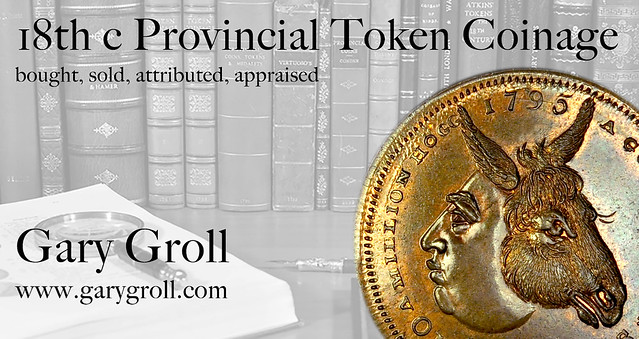
COUNTERMARKED HOLED COINS OF THE PHILIPPINES
Senior Numismatist and Cataloger Kyle Ponterio wrote about countermarks of the Philippines in an October 8, 2020 Stack's Bowers blog article. -Editor

The countermark series of the Philippines is quite vast with a whole array of coins serving as hosts. Utilizing coins ranging from the Spanish colonial period to the early republics of the Americas, and even some from Europe, these countermarks are usually applied to the obverse of the host as stipulated by the decree of 2 October 1832. These markings in their abbreviated form "F.7.o" (for Ferdinand VII) and, similarly later on, "Y.II." (for Isabella II) were applied with a hand-held punch. Prior to the punch change from the earlier "F.7.o" to the more numerous "Y.II.," a decree was issued on 27 August 1834 stating that all pierced coins were no longer legal tender. This, of course, did not sit well with the local inhabitants and nearly caused an uprising.
In order to keep the peace and to prevent a rebellion, the government at Manila issued the decree of 4 September 1834 stating that all holed coins were to be brought to the countermarking office for authorization and would again become legal to circulate freely. The authorization came in the form of countermarks applied to both sides of the perforation as seen on this week's October CCO (Collector's Choice Online) featured highlight—a Filipino 8 Reales with an F.7.o in the center of the obverse and Y.II. on each side surrounding the perforation, all on an 1827 Peruvian 8 Reales host coin.
These fascinating rarities are an integral part of this heavily collected and highly sought after series of Filipino numismatics. The countermarks applied to the perforations were done so at the same time, though they are seldom encountered with only one countermark over the hole. Nearly all of the countermarks on perforated examples can be traced to non-perforated pieces whereby the countermarks were applied in accordance with the original decree. The linking of issues countermarked over the holes to other examples—along with perforated survivors that contain previous countermarks, namely those of Ferdinand VII (F.7.o)—adds a layer of complexity of which many Filipino scholars were not aware until just a few years ago.
At that time, I had embarked upon a massive research project documenting several thousand examples of such countermarked pieces. During my research, I was able to locate approximately 70 different perforated examples, thus allowing for a separation into four major sub-categories: both sides of the perforation; both sides of the perforation (with previous countermark); one side of the perforation, and one side of the perforation (with previous countermark). From the second of these sub-categories, I have documented just 21 examples including the present piece. The provenance of this specimen known to us includes The Money Company auction from 25 June 1979 (lot # 643). It has also been plated in the 1979 work "Monetario De Las Islas Filipinas" by Angelita G. de Legarda and Jose P. Bantug, both famous Filipino numismatists.
To read the complete article, see:
Countermarked Holed Coins of the Philippines
(https://www.stacksbowers.com/News/Pages/Blogs.aspx?ArticleID=countermarked-holed-coins-of-the-philippines)
To read the complete lot description, see:
PHILIPPINES. Philippines - Philippines - Peru. 8 Reales, ND (1834-37). PCGS VF-30 Gold Shield; Countermark: XF Details.
(https://auctions.stacksbowers.com/lots/view/3-OEXK6/philippines-philippines-philippines-peru8-reales-nd-1834-37-pcgs-vf-30-gold-shield-countermark-xf-details)

IRISH MICHAEL COLLINS SOUVENIR BANKNOTE
A souvenir banknote has been created to honor Irish revolutionary Michael Collins. Here's an excerpt from The Irish Post. -Editor
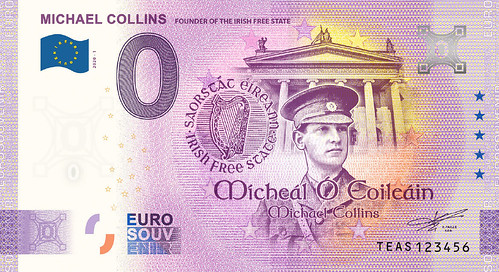
ONE OF Ireland's greatest heroes has been immortalised in a limited edition banknote, released to commemorate 98 years since his death at Béal na Bláth.
Irish revolutionary Michael Collins died on 22 August, 1922, but his legacy remains as strong as ever, with many Irish people considering a personal hero and martyr for the cause of Irish independence.
Now, 98 years after his assassination during the Irish Civil War, banknotes have been created to commemorate the achievements of his short life.
The '0 euro' note looks and feels like any other euro note, including a watermark, holographic protection and UV-responsive tactile marks, but features an image of the 'big fellow' himself in the military uniform of the National Army.
The notes cannot be used as legal currency, but with just 5000 being released and no reprints in the future they are priceless to Irish history buffs, collectors and fans of the 'big fellow' himself.
To read the complete article, see:
Banknote depicting Irish revolutionary hero Michael Collins released
(https://www.irishpost.com/life-style/banknote-depicting-irish-revolutionary-hero-michael-collins-released-194906)
MUDLARKER'S FINDS
Gary Beals passed along this Daily Mail article about a London's mudlarker's find, which include a number of coins and tokens. Here's an excerpt. -Editor
In centuries past, the River Thames became London's sewer as industrial waste, human excrement and even murdered bodies were dumped into its murky waters.
But along with the mounds of foul-smelling rubbish which caused the Great Stink of 1858, historical treasures have also sunk to the river's depths.
Simon Bourne, 39, has spent nine years unearthing these riches by 'mudlarking' along the banks of the Thames, and has revealed his extraordinary haul.
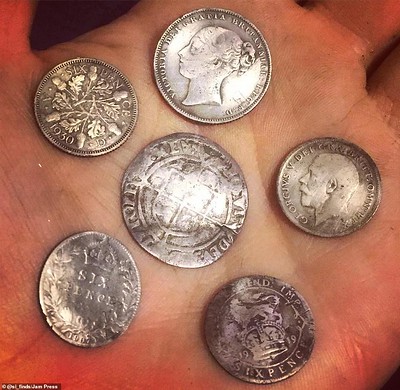
An impressive collection of coins found by Mr Bourne on the banks of the Thames. The old money is still readable, and includes sixpences from 1907, 1919 and 1930. Two other coins bear the faces of monarchs Queen Victoria and King George V
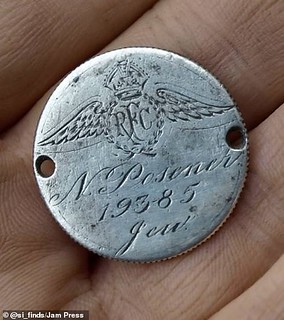 Six years ago, Mr Bourne successfully reunited a man with a dog tag belonging to his grandfather that he had found on the banks. The tag bore the name N Posener (left) and was emblazoned with the Royal Flying Corp service number 19385 from the First World War. After sifting through the archives to find Nathan Posener (right) in the 1911 population census aged 18, he found that he had lived at 292 Commercial Road in Whitechapel, close to the spot he found the dog tag
Six years ago, Mr Bourne successfully reunited a man with a dog tag belonging to his grandfather that he had found on the banks. The tag bore the name N Posener (left) and was emblazoned with the Royal Flying Corp service number 19385 from the First World War. After sifting through the archives to find Nathan Posener (right) in the 1911 population census aged 18, he found that he had lived at 292 Commercial Road in Whitechapel, close to the spot he found the dog tag
The graphic designer, from London, explained how his interest in mudlarking piqued after stumbling across some pottery by accident.
He said: 'In 2011 I went to the Thames foreshore after a bike ride and started finding pottery. My interest increased from that moment and I returned and met up with like-minded people and realized there was much more to be found and it grew from there.
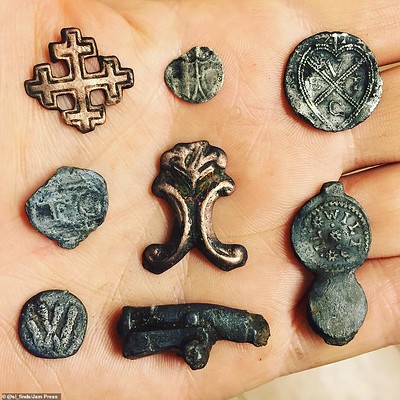
A collection of coins and medals found Mr Bourne, who said: 'I use my eyes, a metal detector, Wellies, a trowel or spade, and a Pinpointer, and spend four to eight hours a week searching'
To read the complete article, see:
500-year-old coins, a live World War II grenade, a Magnum revolver and HUMAN SKULLS: Mudlarker reveals extraordinary items he has unearthed from shoreline of the River Thames
(https://www.dailymail.co.uk/news/article-8818677/Mudlarker-reveals-extraordinary-items-unearthed-shoreline-River-Thames.html)

CASCADE REFINING DATE-STAMPED INGOTS
A new article on the ALL ENGELHARD site highlights the rare date-stamped ingots of the Cascade Refining company. -Editor

You've likely seen Cascade Refining ingots offered for sale on eBay and other platforms from time to time. Given their 1980 era vintage and infrequent availability, we have good reason to believe they are quite rare. Cascade Refining ingots are beautifully poured in old world character, all odd-weight and individually hand-stamped oneof-a-kind ingots, often compared with the likes of Homestake Mining, Bunker Hill, and US Assay. A unique and signature characteristic of Cascade Refining ingots is that their serial number in fact indicates the production date.
To illustrate, the above photo denotes a serial number of 122480, translating to 12 = December, 24 = 24th day of the month, and 80 = 1980. What the heck were they doing working on Christmas Eve anyway?! Santa would not be pleased. This date-serial format was used for over 95% of Cascade Refining's retail production ingots. There are, however, a scant quantity of 5-digit serial numbers with no date association that we have yet to decipher, and these may possibly have been the result of stamping errors, an occurrence we are all too familiar with in vintage Engelhard ingots.
Cascade Refining, Inc. produced silver and gold ingots between 1977 and 1993. While their production of gold ingots was quite limited, silver production included approximate weight class categories of 5oz, 7oz, 10oz, 25oz and 100oz ingots, and the company continues to produce 1oz silver rounds today. The rarity of these beautiful examples is highlighted by the fact we have logged only 208 Cascade Refining serial numbers across every weight class and composition since we started studying these pieces a decade ago. Total estimated mintage for all examples presented on our Cascade Refining Definitive Page suggest less than 4,500 ingots were ever produced. This indicates we have logged approximately 4.6% of Cascade's total production. This 'logged' percentage is consistent with ingot production we have recorded for other refiners of this era, once again confirming that our estimated mintage numbers are reliably accurate.
History demonstrates that similar ingots predominantly minted following the 1979/1980 melts had a higher percentage survival rate and were/are cherished and held by strong hands. The beauty of these classically produced ingots, along with their unique date-stamp serial numbers, were the intriguing characteristics that saved most of these examples from being melted. Ironically, most collectors have sourced these pieces from Utah, as the City of Layton, home of Cascade Refining, Inc., is in fact just north of Salt Lake City.
To read the complete article, see:
RARE DATE-STAMPED INGOTS
(https://allengelhard.com/wp-content/uploads/2017/08/AGWire-Cascade-Refining-10-10-20.pdf)
THE BOOK BAZARRE
THE BIBLIOMANIAC'S MANTRA
Harry Waterson submitted this review of a new novel about the children's publishing world; bibliophiles can relate to the observation about our ever-expanding collections. -Editor
The Stratemeyer Syndicate was a publishing company that produced a number of mystery book series for children, including Nancy Drew , the Hardy Boys , the various Tom Swift series, the Bobbsey Twins, the Rover Boys , and others. They published and contracted the many pseudonymous authors doing the writing of the series from 1899 through 1987, when the syndicate partners sold the company to Mega-Books.
"How many do you have now?" Said Robert.
"Four thousand two hundred and seventy three" said Sherwood.
"Wow." said Robert. "All children's series books?"
"All Stratemeyer books and all published before World War II. You have to set some boundaries as a book collector."
"I had no idea he published that many titles," said Robert.
"I'd read it was several hundred, but four thousand?"
"They're not all unique titles," said Sherwood. "I started out trying to find one copy of each title, then upgraded to getting each title in a dust jacket, then each in a first edition, and then I started in on later printings, changes in the dust jacket designs and so on. It's a funny thing about book collecting - no matter how tightly you define your collection, it keeps expanding."
Lovett, Charlie - Escaping Dreamland, Blackstone Publishing, Ashland, OR 2020 Kindle Edition, Chapter XVII (57% in) Kindle Edition is $8.69
 Escaping Dreamland just came out Sept. 22,
2020. It is a lovely whimsical novel about the
world of publishing children's mysteries just
before WWI and one writer's journey of research
and discovery into one legendary series. The
novel is about what happened in Manhattan
children's book publishing between 1895 and
1915 and another writer's 2010 quest into that
world to find answers to his own contemporary
writing issues. For a bibliophile New Yorker it
was especially great fun. Most of the libraries
were old friends. All wrapped up in an intelligent
dust jacket of publishing scholarship.
Escaping Dreamland just came out Sept. 22,
2020. It is a lovely whimsical novel about the
world of publishing children's mysteries just
before WWI and one writer's journey of research
and discovery into one legendary series. The
novel is about what happened in Manhattan
children's book publishing between 1895 and
1915 and another writer's 2010 quest into that
world to find answers to his own contemporary
writing issues. For a bibliophile New Yorker it
was especially great fun. Most of the libraries
were old friends. All wrapped up in an intelligent
dust jacket of publishing scholarship.
The Hardy Boys by Franklin W. Dixon was a staple of my youth. I had no idea it was written by umpteen different writers. Just like a TV series.
For more information, see:
Escaping Dreamland
(https://charlielovett.com/books/escaping-dreamland/)

LOOSE CHANGE: OCTOBER 11, 2020
Here are some additional items in the media this week that may be of interest. -Editor
New American Eagle Reverse Designs
I didn't get a chance to cover this in last week's issue, but Coin World's Bill Gibbs wrote the U.S. Mint's planned new designs for the reverse of the American Eagle bullion coins. -Editor

The United States Mint on Oct. 1 unveiled the new reverse designs for the 2021 American Eagle gold and silver coins. The designs are scheduled to appear in midyear, with Mint officials thus far silent on how the design transition will be conducted before the new coins are released.
The new reverse of the American Eagle silver coin will depict an eagle in flight with an oak branch in its talons, a design favored by the Commission of Fine Arts for the American Eagle gold bullion coin.
The American Eagle gold coin will depict an eagle's head in close-up; the Citizens Coinage Advisory Committee recommended a similar design for the reverse of the silver coin, principal differences being with the inscriptions, including placement of the mottoes.
To read the complete article, see:
Mint unveils American Eagles with new reverse designs
(https://www.coinworld.com/news/us-coins/mint-unveils-american-eagles-with-new-reverse-designs)
Walmart Keeps the Change
A Pennsylvania Walmart customer got a surprise instead of change for her purchase. -Editor
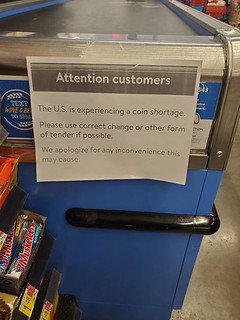 A national coin shortage has some retailers asking customers to pay with credit or debit cards, or use exact change if possible.
A national coin shortage has some retailers asking customers to pay with credit or debit cards, or use exact change if possible.
But a Lehigh Valley woman said the Whitehall Township Walmart store took it a step further and refused to give her change — with no advance warning.
"We gave them $42; I was supposed to get 84 cents back.
Richards, who paid at the MacArthur Road Walmart's self-checkout line, said she got no satisfaction when she questioned the lack of change at the register. She then went to customer service and, after waiting several minutes, she said, the store handed her the change.
Avani Dudhia, a Walmart spokesperson, said store personnel believe Richards' event was an isolated incident, and that signs are posted at each register asking customers to provide exact change or other means of payment. She also said the company's policy has been giving customers the choice of receiving change or donating the difference.
To read the complete article, see:
Shortchanged? Lehigh Valley shopper says she was refused 84 cents at Walmart amid COVID coin shortage
(https://www.mcall.com/business/mc-biz-walmart-lehigh-valley-customer-denied-change-back-20201005-czmsy5pppvesxddpmsel34ige4-story.html)
The St. Luke Finance Corporation in the 1920s
Last week we discussed Maggie Lena Walker's St. Luke bank. Coincidentally, the week the Museum of American Finance is offering a Zoom program on the St. Luke Finance Corporation in the 1920s by the author of Banking on Freedom, published in 2019 by Columbia University Press. -Editor
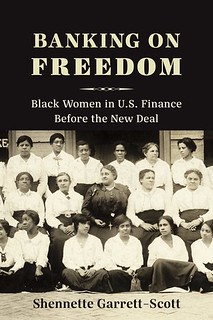 Shennette Garrett-Scott on "Dreaming of Colored People: Black Women and the St. Luke Finance Corporation in the 1920s"
Shennette Garrett-Scott on "Dreaming of Colored People: Black Women and the St. Luke Finance Corporation in the 1920s"
MoAF/Fordham Webinar Series
Wednesday, October 14, 2020 | 12:00 PM to 1:00 PM
Join us for a talk with award-winning author and professor Shennette Garrett-Scott on her book Banking on Freedom: Black Women in US Finance Before the New Deal. African American women in 1920s-era Harlem participated in real estate and other investment schemes for complex reasons. They often hoped to combine individual gain and collective uplift in their financial pursuits. The St. Luke Finance Corporation was one such scheme that showed great promise but struggled against structural and institutional inequities as well as criticism from some sectors of the Black community.
To read the complete article, see:
Shennette Garrett-Scott on "Dreaming of Colored People: Black Women and the St. Luke Finance Corporation in the 1920s"
(https://www.moaf.org/events/general/2020-10-14-shennette-garrett-scott-on-dreaming-of-colored-people-black-women-and-the-st-luke-finance-corporation-in-the-1920s)
To read the earlier E-Sylum article, see:
MAGGIE LENA WALKER'S SAVINGS BANK
(https://www.coinbooks.org/v23/esylum_v23n40a30.html)

